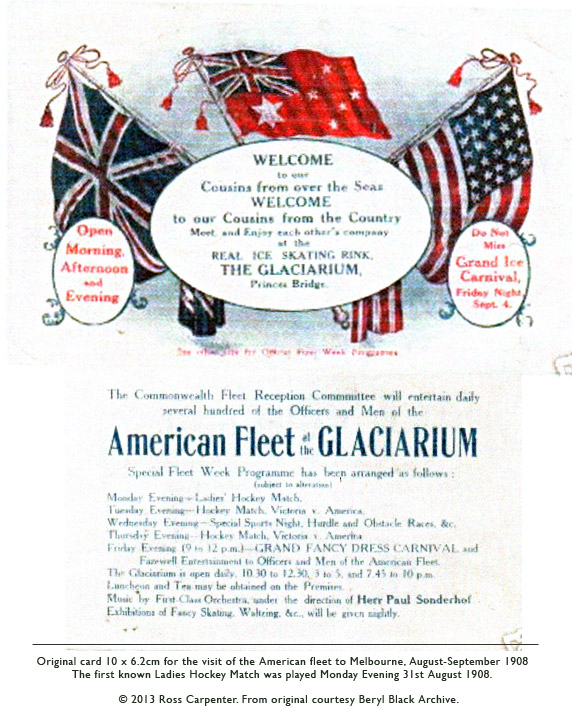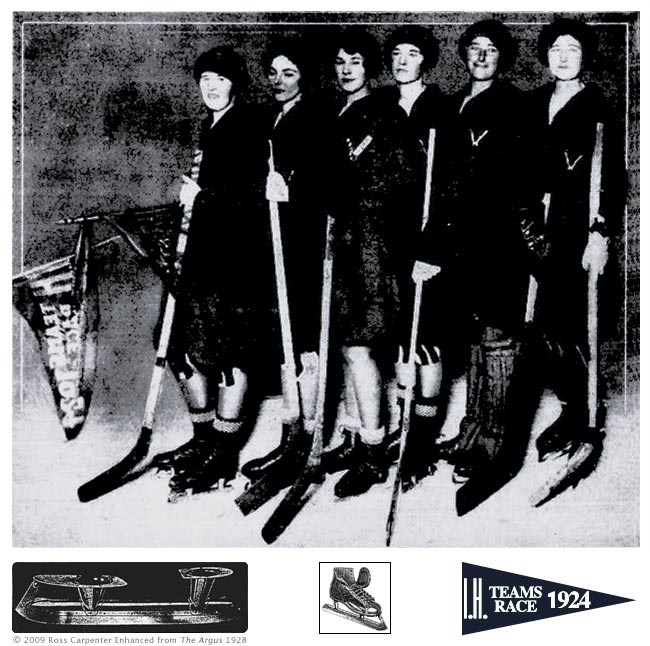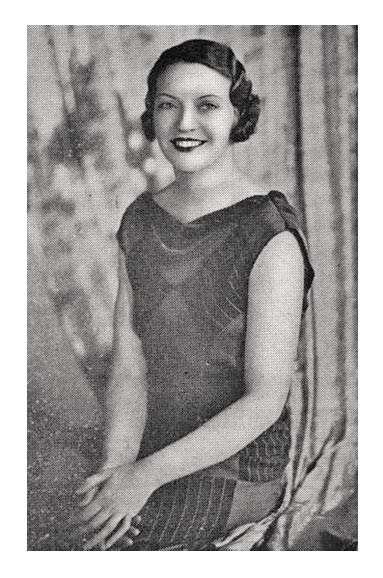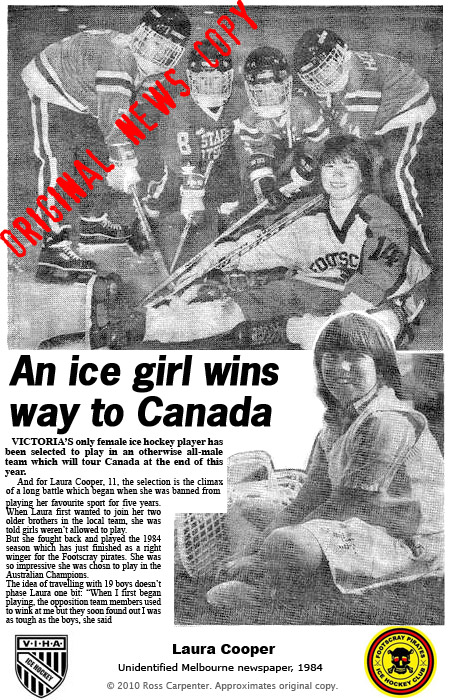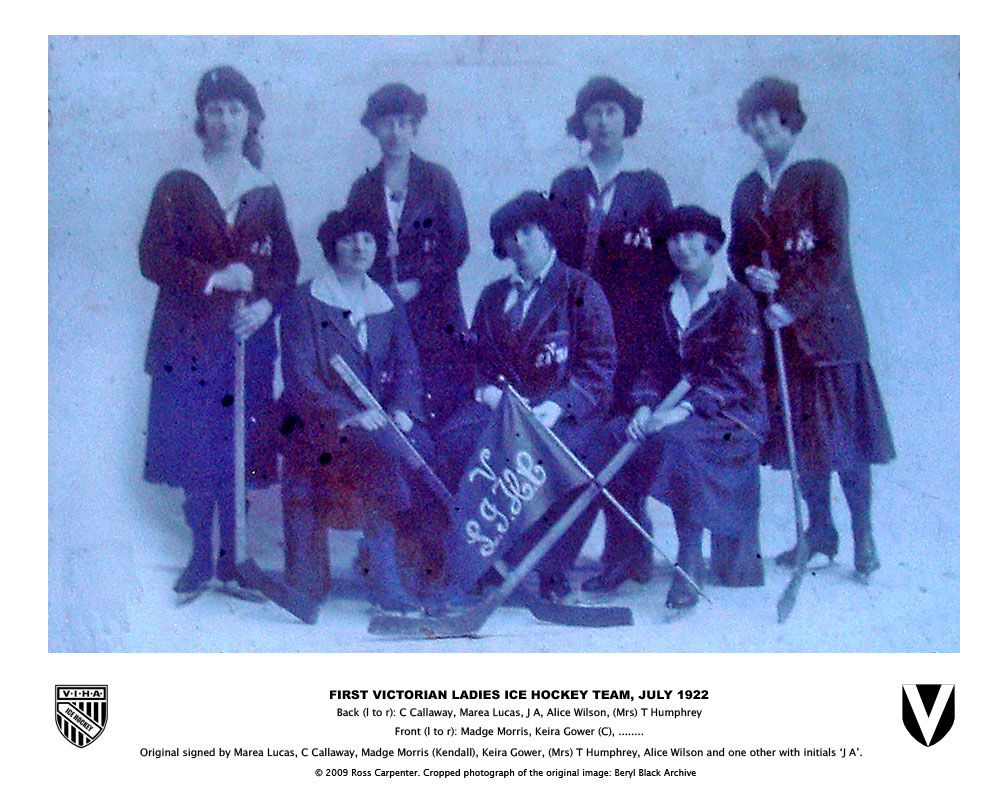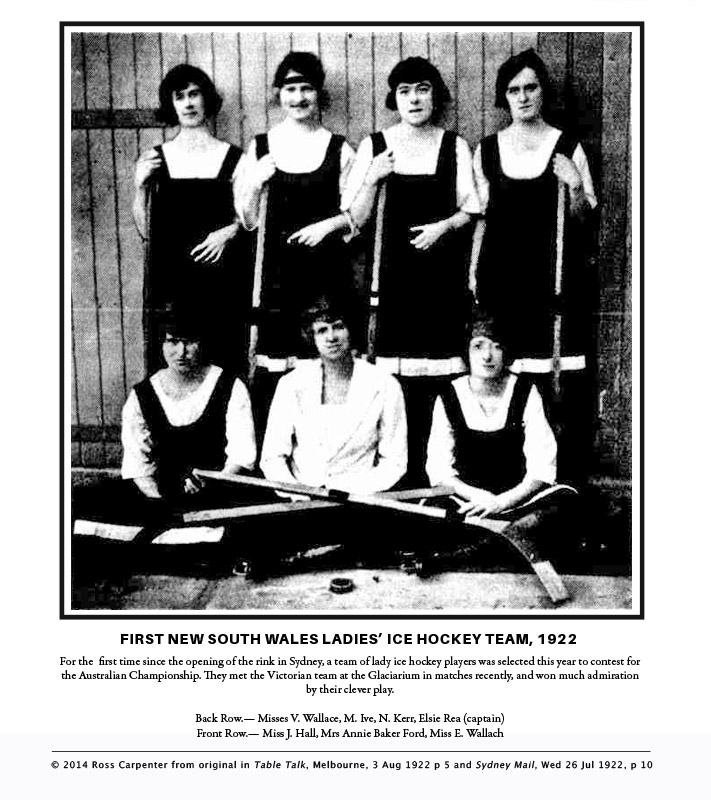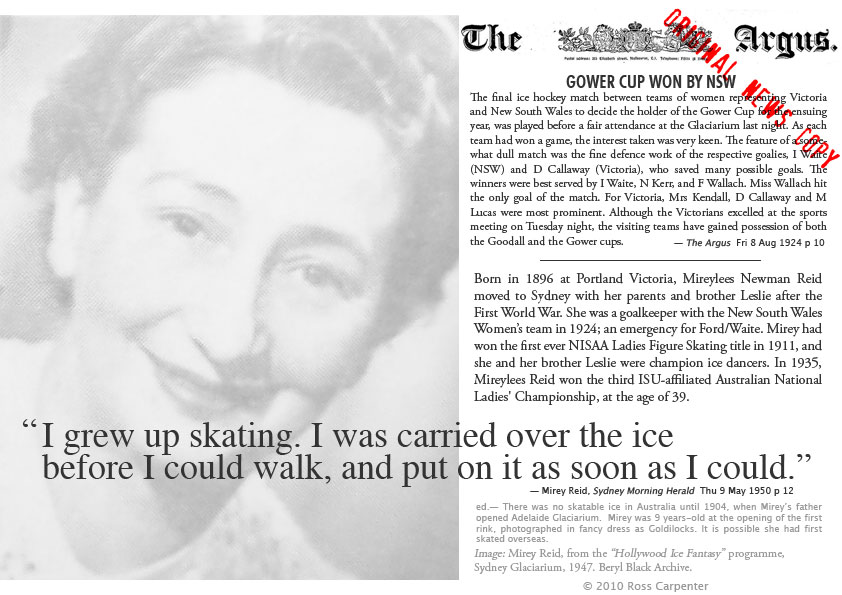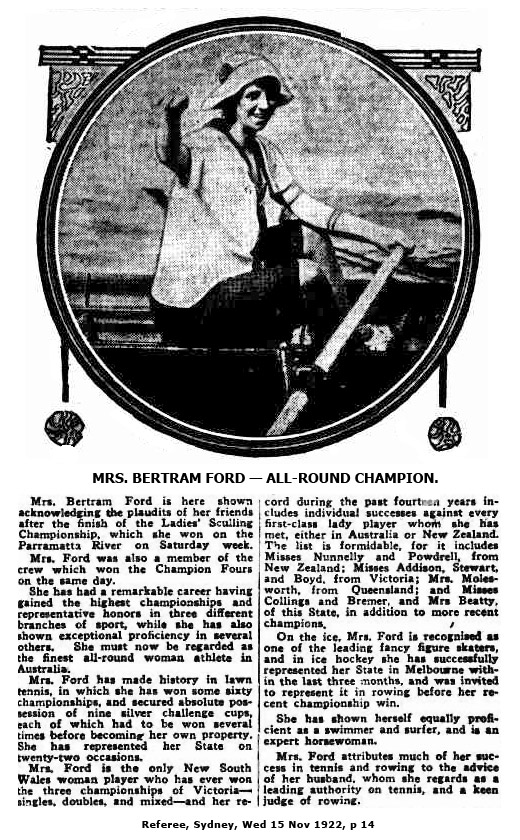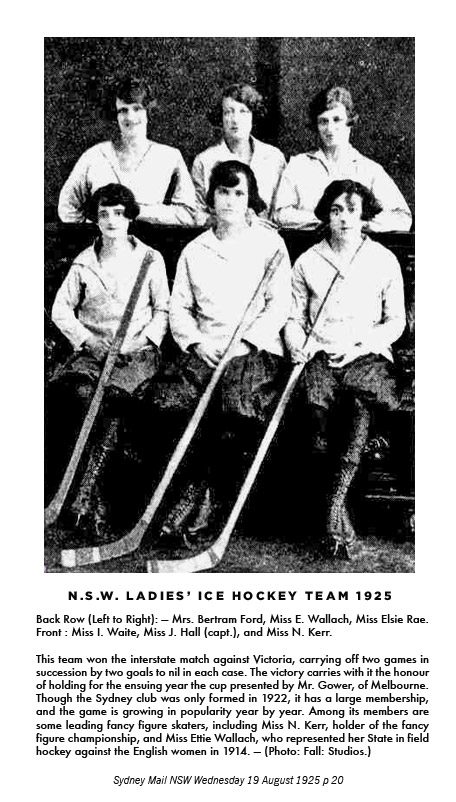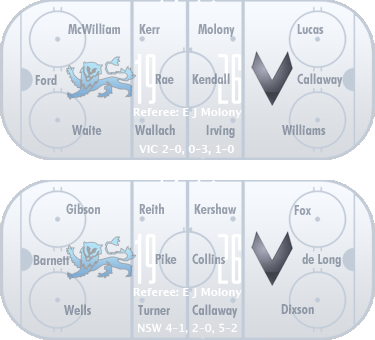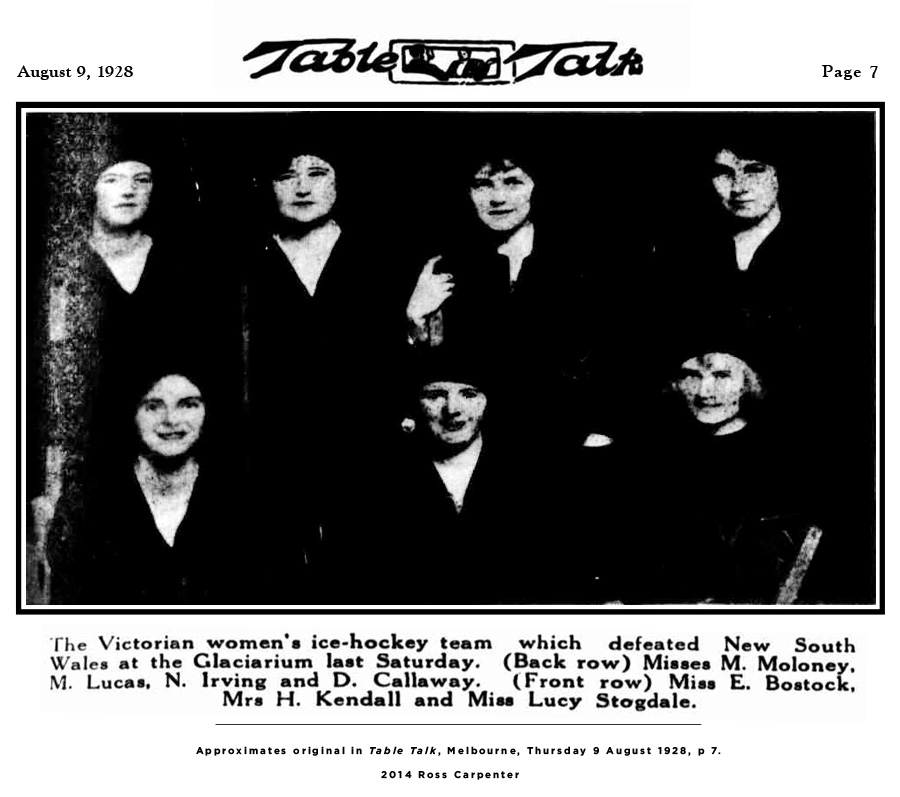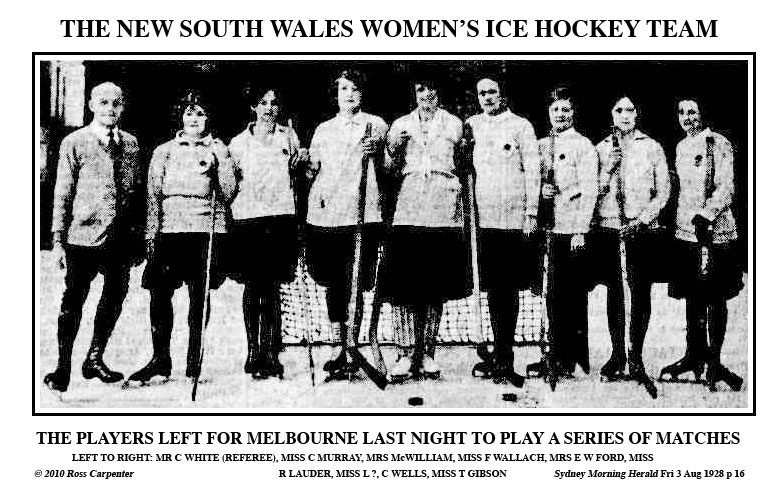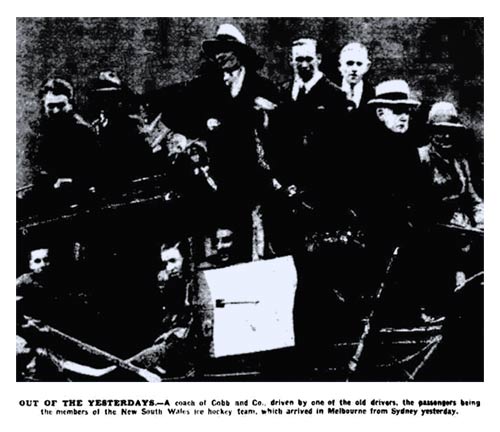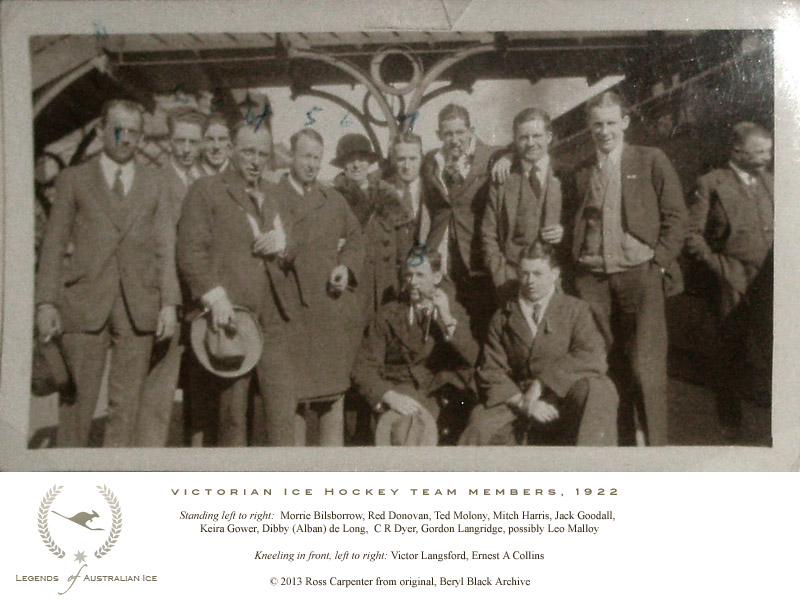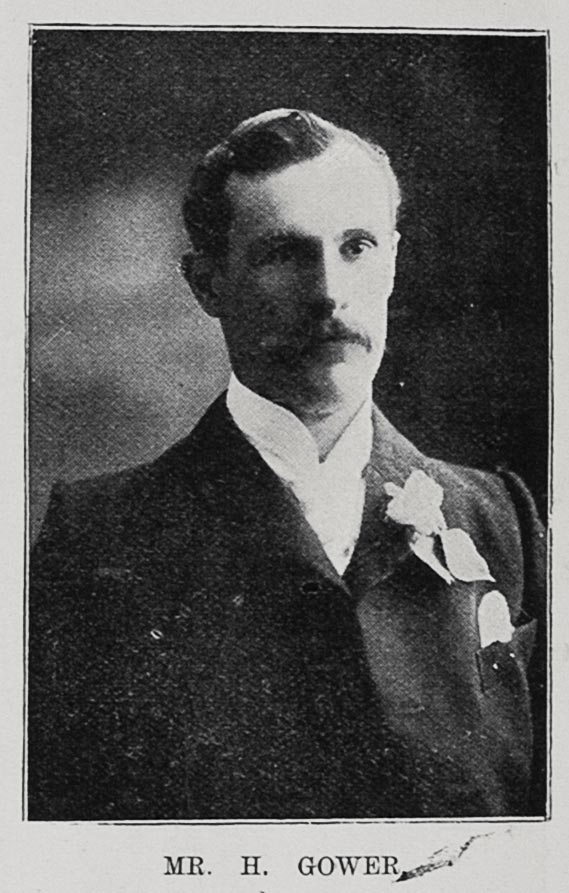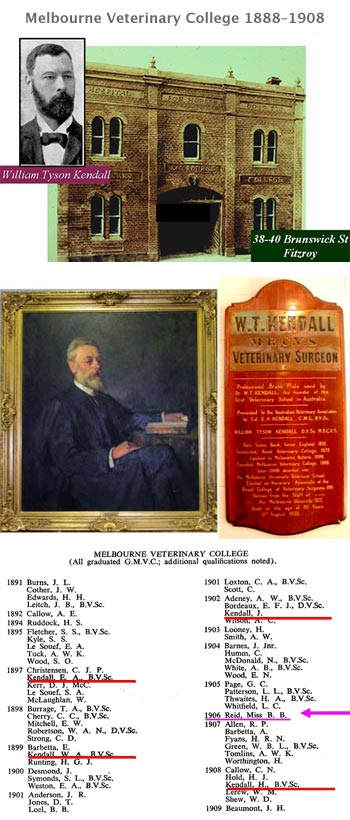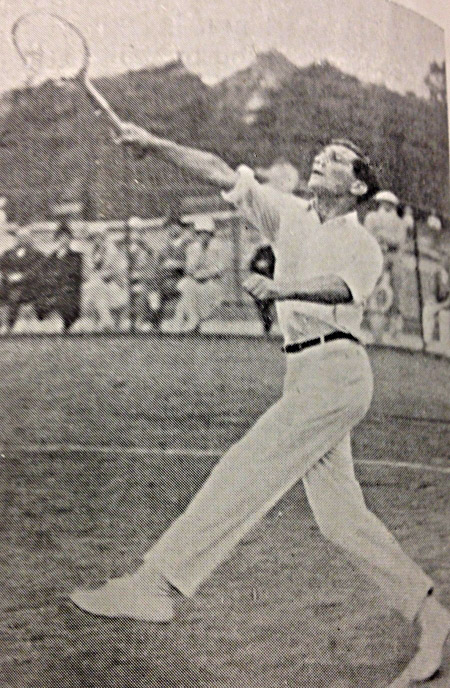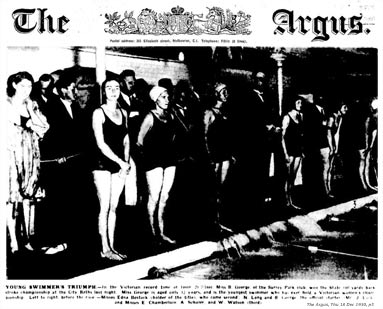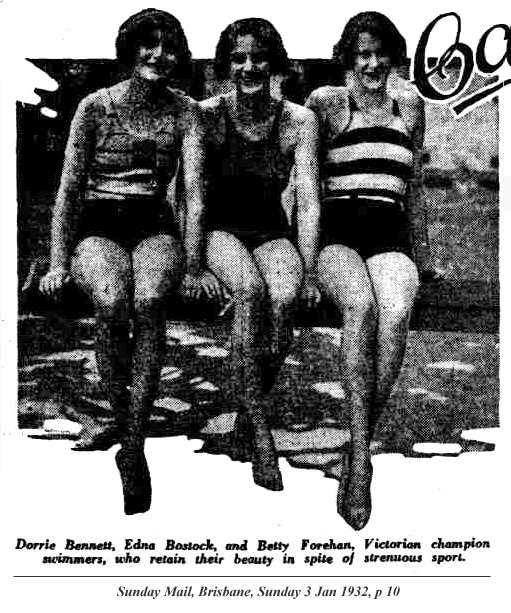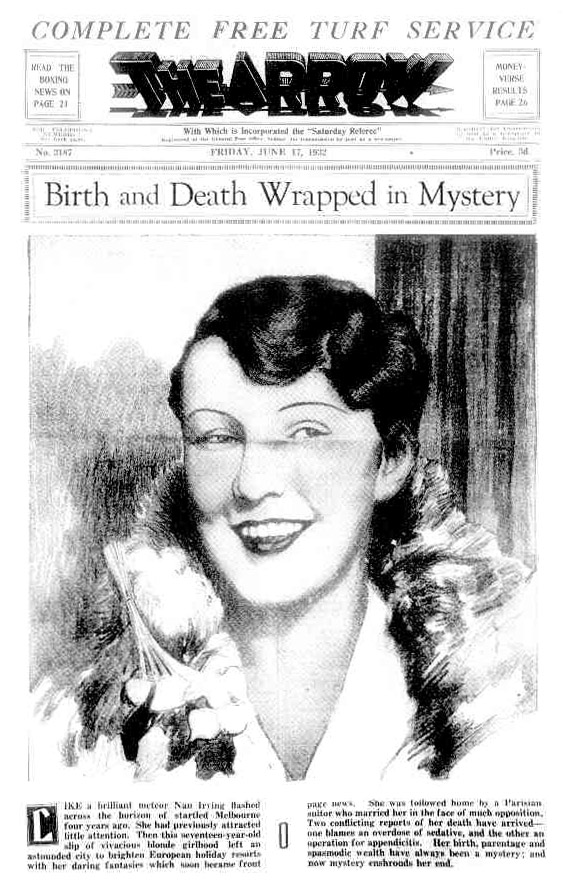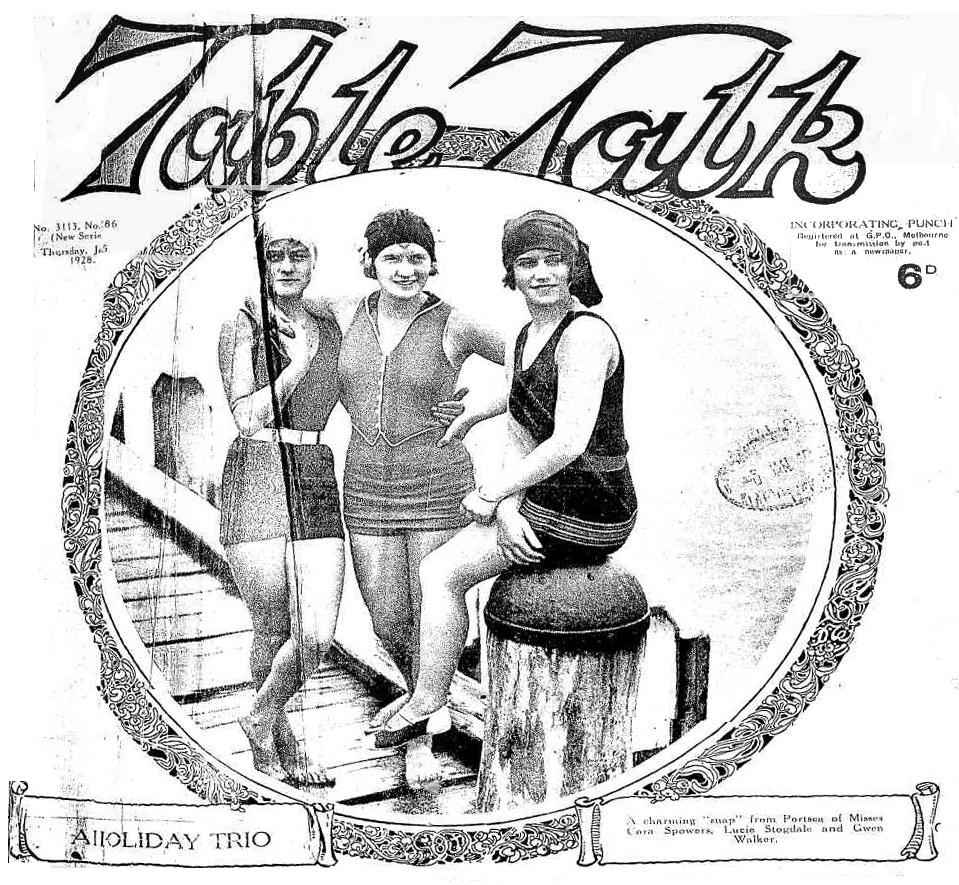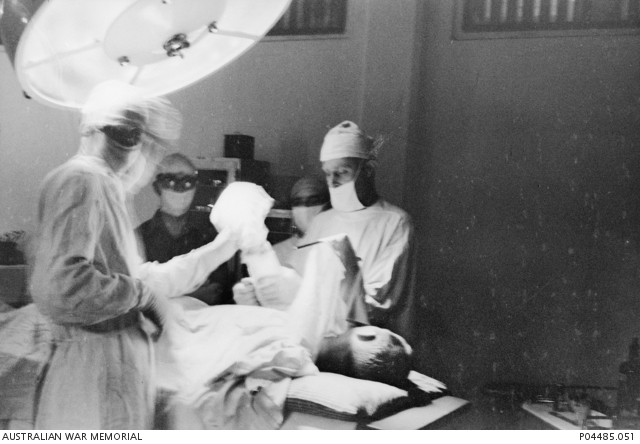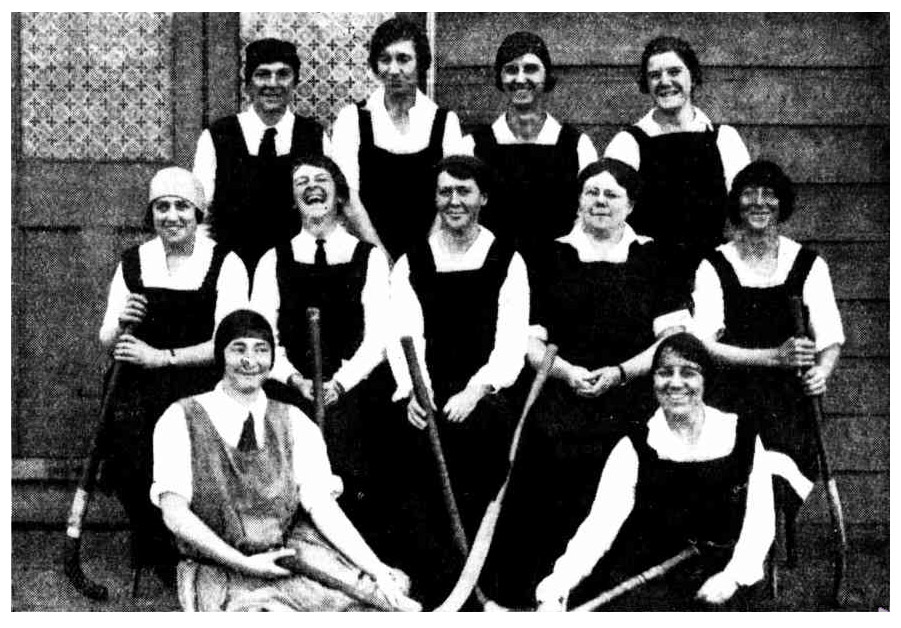Legends
home
1936 1st AUSTRALIAN Winter Olympian
1947 1st International Figure Skating GOLD Medallist
1960 1st Australian Olympic and World Championship ICE HOCKEY Teams Squaw Valley California USA
1961-2 2nd AUSTRALIAN Ice Hockey World Championship Ice Hockey Team Colorado USA
1963-4 2nd OLYMPIC Qualification ICE HOCKEY Team Tokyo Japan
1987 1st International Ice Hockey MEDAL Perth Australia
2008 Ice hockey World Championship PROMOTION TO DIVISION I Newcastle Australia
The First Women's Ice Hockey
1914 on
ORGANISED ICE HOCKEY FOR WOMEN has been played in Australia with the sports and novelty nights organised by Dunbar Poole at Sydney Glaciarium from 1907, and the ice sports carnivals held at Melbourne Glaciarium from 1906. These were preceded by the sports programme at Adelaide Glaciarium from April 1905 and, before then, the Melbourne and Adelaide roller rinks in the form of roller polo (see Figures). The first women's ice hockey match on record was held at Melbourne Glaciarium on Monday evening, 31st August 1908 on the occasion of a visting American fleet (image opposite). Total Hockey, the official encyclopaedia of the NHL, places the first ever women's game at Ottawa in Canada, where the Government House team defeated the Rideau ladies team in 1889. An account in the Ottawa Evening Journal newspaper on March 8th that year records two teams of four women per side competing at the Rideau Skating Rink in Ottawa. Reports which place the first women's game in Barrie, Ontario in 1892 are incorrect. On February 11th, 1891, one of the earliest newspaper accounts of a seven-a-side game between women appeared in the Ottawa Citizen, and the first female club team (the Love-Me-Littles) was formed in Kingston, Ontario at Queen's University in 1894. Women's teams were formed at McGill University and in the Ottawa Valley in 1896, and in 1900 the first women's ice hockey league in the world was organized in Québec with three teams. By the early 1900s, women's teams were common throughout most of the Canadian provinces.
A decade earlier, fourteen year-old Lady Isobel Stanley (1875 – 1963), daughter of Lord Stanley and a pioneer of the women's game, was one of the first women to be photographed playing hockey on the natural ice rink at Rideau Hall, the Stanley family residence in Ottawa. Rideau Skating Rink — site of the first ever women's game near Rideau Hall — is also important in Australian hockey history, because it was there that Victorian-born Tommy Dunderdale began ice hockey sometime after he arrived in Canada in 1894, in the same leagues as Herbert Blatchly, captain of the first Australian ice hockey team of 1906. Blatchly had a major influence on the early development of the Australian game and, while Dunderdale's influence was less obvious and direct, his teammate Charles Uksila and sister Lena Uksila, contributed significantly from 1920, and probably earlier (also see Ted Molony and Leslie Reid). Organised women's ice hockey was first been played in the United States at St Nicholas Rink in New York in 1917, although it had probably started a little earlier because the first international women's ice hockey tournament was held in Cleveland, Ohio between American and Canadian teams in 1916. At that time, New York was the only city in America with an amateur ice hockey league and Robert Jackson, the first ice hockey captain of Victoria in 1909, was an instructor at the Ice Palace rink in Manhattan, corner of Riverside Drive and 181st Street, near the George Washington Bridge. It was there, in 1917, that he first performed with Lena Uksila. In so doing, he extended Australia's earliest links with developments in amateur hockey for both men and women in North America, as well as the world's first professional league, formed in Michigan where the Uksilas lived.
A women's ice hockey game was advertised in the Sydney Morning Herald on July 21st, 1914 — about the same time as America and 6 years after the first game on record in Melbourne in 1908. Other events included quarter- and half-mile speed skating races, a ladies' quarter-mile egg and spoon race, and hurdle races (see Racing Champions). These speed skating races and other related events were a regular feature of the skating season in both Melbourne and Sydney, and the forerunners of the national speed skating and women's ice hockey championships in New South Wales and Victoria. [2] National women's hockey in Australia commenced in July 1922 when the first Gower Cup for women's Interstate ice hockey was contested. [4] These developments had flowed from the major rebuilding of Australian ice sports from 1920, when the Uksilas first visited Australia as "athletic trainers". Like the Goodall Cup, this National trophy for women was also a Melbourne institution, and it is indeed unfortunate its tradition was also somehow lost, like Victoria's Junior Public Schools competition (1931), the first true, age-delimited junior ice hockey league in Australia. Particularly so, because the Gower Cup is a part of Goodall Cup history.
Following the deaths of 60,000 Australians in the war, the Gower Cup dropped into ice sports like a bookend for the next decades. It was the missing pair of the Goodall trophy, and its arrival coincided, both symbolically and literally, with new life for post-war ice sports. In that one brief moment, organised National women's ice hockey was born in Australia and, soon after, a brand new generation of National men's ice hockey, and the first organised junior ice hockey and racing league in Australia. Throughout this decade, Victoria was beleaguered by one rink problem after another, but each was neatly solved, and these appear to have still been the halcyon years for ice sports there, as well as in New South Wales. The Gower Cup was donated, quite symbolically it seems, by Miss K Goodall who was probably the wife of John Goodall (1893–1960), the Victorian ice hockey player who presented the Goodall Cup trophy to the VIHA, for the inaugural men's Interstate competition of 1909. [4] This was Goodall's second marriage, and he did not formally wed Kathleen until 1926, a few years after the Gower Cup was introduced. However, it is very likely she was the Cup donor. Kathleen Fanning (1900–1993), was a well-known soprano who regularly appeared on stage in Melbourne and Sydney, and later sang on radio and recorded songs. In all probability, the women's Interstate ice hockey competition was conceived by John Goodall, and perhaps his partner or, at least, in her honour. Its introduction coincided with the Victorian and NSW Association delegates conference held in Melbourne in 1922. This meeting was convened to formalise arrangements for the first National ice hockey association proposed to be established the next year, during the 1923 Interstate series held in Sydney. [2] John Goodall became its foundation president.
These events were also closely related to developments occurring in North American amateur ice hockey. Sir H Montagu Allan CVO, son of Sir Hugh Allan, had donated the Allan Cup in 1908, the year before the Goodall Cup Interstate series first commenced. His first cousin, Lady Isobel Brenda Meredith (Allan), donated the Lady Meredith Cup in 1920, two years before the Gower Cup. This was the first ice hockey trophy to be competed for amongst women in Canada, and Lady Meredith was the wife of Allan's friend, Sir Vincent Meredith, of Montreal, a son of John Cooke Meredith. The Scottish Allans were shipowners and financiers like the Australian Howard-Smiths. Allan was a banker, ship owner and sportsman, who inherited the Allan Line (Montreal Ocean Steamship Company) from his father, one of the wealthiest men in the world at the time of his death. It was established during the years the Howard-Smiths were forming their Australian shipping line, which was also inherited by sons, including Harry Howard Smith. The Merediths were Anglo-Irish financiers like the Australian Goodalls, descended from Rev Thomas Meredith of Dublin, Ireland, who served as Governor of McGill University in Montreal, like the McLennans who were friends of Jim Kendall. Meredith's seven brothers were stockbrokers, bankers, leaders of the Conservative Party, mayors, horse breeders, and presidents of the stock exchange. Collectively, they are remembered as the "Eight London Merediths", remarkable for the success they individually earned in legal, official and financial roles in London, Toronto and Montreal. The Goodalls operated the Pacific Coast Steamship Company from San Francisco for the full length of the West Coast of North America. These early patrons of amateur ice hockey in Canada, England and Australia shared similar cultural heritage, education, business interests and political leanings. Some were known to each other through their shipping companies, and some may even have been related (note 3 below).
The first Australian women's Interstate competition was held in Melbourne in 1922. Thereafter, the Interstate ice hockey and speed skating series were held simultaneously for both men and women each winter, usually in August, and as part of a National ice sports carnival which alternated between Sydney and Melbourne. The local competition in Victoria was organised to assist selection of players for the Goodall Cup team. Matches were played in two halves by one line of six players, and two 'relay' or substitute players from 1926 in Melbourne (see Ted Molony). The State ice hockey teams with the most wins from three tests took custody of either the Goodall or Gower trophies until the next series. In 1925, the Interstate series consisted of six tests, three played in Melbourne and three in Sydney, probably to honour Jim Kendall, who retired as a player that year, but continued to coach. [14]
Other main events at the week-long carnivals included the quarter-mile and half-mile ice races, and the Teams Race, also known as the Flag Race, which was possibly a mixed-sex speed skating team relay race. Or perhaps couples raced holding strings between them. In 1924, the winning teams were reported as mixed pairs and, on another occasion, a couple was disqualified for dropping their string. The Women's Athletic Club at Melbourne University also had similar track and field events in the 1920s. [44] All ice racing events were organised separately for men and women, but they were otherwise identical in terms of distances and competition format. During the 1920s, the annual Interstate carnival regularly attracted up to two thousand spectators in both Melbourne and Sydney, two or three times the best attendances of their modern day equivalents. In 1925, 4,000 people attended a skating carnival, and 1,000 skated. The highest attendance ever reported was 5,000. Game times, match results and reports of both local and Interstate hockey matches were reguarly reported in the sports sections of Melbourne newspapers, and broadcast on radio 3AR by 1930.
Victoria won the inaugural Gower Cup in 1922, and again in 1926 and 1928. New South Wales won in 1924 and 1925. The results of other contests are not yet known. Among the first women to represent Victoria in ice hockey were Victoria's first captain Keira Gower; Victoria's longest-serving captain Madge Kendall (née Morris); Winnie Williams; Maffie Molony, wife of Ted Molony; A Wilson; team secretary Marea Lucas; and goalie Dina Callaway who appeared in the "Butterfly Ballet" produced by Enders and Cambridge in 1924. From the same record, the first New South Wales representatives were goalie Annie Ford (captain eight times), Miss Nancy Kerr; Muriel Wallach; Miss K Lauder; Miss M Gourlay; and reserve goalies Miss Ida Waite and Mirey Reid, only daughter of H Newman Reid. [4] Many were members of the New South Wales Figure Skating Club, led by Charles Maclurcan, the 1912 national men's skating champion. Sadie Cambridge was also a prominent member during the twenties. They were soon followed by Victorians Edna Bostock and Nan Irving, and quite a few others whose names appear in old newsprint between 1924 to 1930. Many were figure skaters, ice racers and State skiing champions. The Victorian Ice Hockey Association retained its original name from 1908, but it was reported as the Victorian Ice Hockey Association and Speed Skating Club in 1932. [42] The naming of the first National Ice Hockey and Speed Skating Council established in 1923, and its State counterpart formed a year or so earlier in NSW, originated from the format of these Interstate ice hockey and speed skating carnivals. They had been mutually agreed by both States at the delegates conference held in Melbourne on July 29th, 1922. [2]
This first era of women's hockey in Australia peaked in the 1920s and 1930s, in parallel with North America, where there were also teams in a few areas of the United States, and leagues and tournaments in almost every region of Canada. The University of Toronto defeated McGill University in the first intercollegiate women's hockey tournament in 1921. Some of the best Canadian teams met annually in an East-West tournament to declare a national champion. The Preston Rivulettes (Ontario) became the first dynasty of women's hockey, a hockey tour de force in the 1930's. The organized women's game declined after World War Two and, throughout the 1950s and 1960s, it came to be regarded as little more than a curiosity. Hockey by then was assumed to be the preserve of men and boys, an attitude confirmed in 1956 when the Ontario Supreme Court ruled against Abby Hoffman, a nine-year-old girl who challenged the "boys only" policy in minor hockey. Hoffman had already played most of the season with a boy's team, disguising her sex by dressing at home and wearing her hair short.
However, a revival began in the 1960s, although most girls attempting to join boys teams were still rejected. But women's hockey slowly gained ice time and, as the new generation of players grew up, they demanded a chance to play at colleges and universities. Eleven year-old Laura Cooper was the only female ice hockey player in Melbourne in 1984. She fought for the right to play in the boys team and won her way to a tour of Canada. Canadian intercollegiate women's hockey began in the 1980s and the NCAA recognized the game in 1993. An international breakthrough came in 1990, when eight countries contested the first Women's World Ice Hockey Championship. Participation grew exponentially in the decade that followed. Women's hockey made its Olympic debut at the 1998 Games in Japan. In 2002, the Mission Bettys of California became the first all-girls team to enter the Quebec International Pee Wee Tournament, one of the world's largest youth competitions.
In 1930, Lewis Luxton attended an ice hockey match at Melbourne Glaciarium, and later wrote a description of the team structure, rules, equipment and game play that had evolved in Australia since inception in 1906, which was published in The Argus newspaper in Melbourne (link below). Much of this had emerged from the pioneering work in Australia by Herbert Blatchly, Robert Jackson, the Uksilas, and others. It was implemented from 1920 through Leslie Reid and John Goodall in Sydney and Melbourne, respectively. The first women's interstate competition seems to have lasted 8 years, then lapsed after the 1930 season with the onset of the Great Depression. Today, the prize for the National Women's open ice hockey championships organised by Ice Hockey Australia is known as the Joan McKowen Trophy. Four teams compete in today's Australian Women's Ice Hockey League (AWIHL): Melbourne Ice, Adelaide Adrenaline, Newcastle North Stars, and Brisbane Goannas.
![]() Eastern Nova Scotia - Prince Edward Island | Map | Luxton article | 1930 | AWIHL Premiers | 2008 |
Eastern Nova Scotia - Prince Edward Island | Map | Luxton article | 1930 | AWIHL Premiers | 2008 |
Historical Notes:
[1] The historical news articles below are transcribed from digital copies of the original 1920s and early-1930s newspapers. They are of variable quality and some figures and names, particularly initials, may not be transcribed accurately. In time, any errors will be corrected from original hard copies at the State Library Victoria.
[2] The VIHA trophy for the men's ice hockey competition was named the Sutherland Cup in the 1920s. Although some published records show Essendon IHC won in 1926, St Kilda IHC reportedly defeated Essendon 2-0, and were both VIHA minor premiers and premiers, which is unsurprising given the roster. The Premiership players were captain Morrie Bilsborrow (right defense), Victor Langsford (right wing), C Kershaw (centre), G McKennell (left wing), W Glese (left defense), Alban De Long (goals). [The Argus, 7 Sep 1926, p. 12] The Sutherland Cup became the Kleiner Cup in the 1940s, named after Harry Kleiner, owner of St Moritz rink. Today, it is the Russell Jones Premiership Cup (since 2008).
[3] From 1872 until 1916, two great uncles of John Goodall operated the Pacific Coast Steam Ship Company all along the West Coast of North America (see Goodall). Sir Simon Fraser (1832–1919), grandfather of former Prime Minister Malcolm Fraser, was born in Pictou, Nova Scotia (map at link above). He grew up there and immigrated to Australia in 1853 at the age of 21, where he bought extensive estates in the Western District of Victoria. There he became a leader of the wealthy wool-growing class known as the squatters, which included the Armytage family. He was a Victorian delegate to the Imperial Conference in Ottawa, Canada in 1894. Robert Reid, uncle of Henry Newman Reid, was also in Ottawa in May 1894, the year after Lord Stanley donated the Stanley Cup (see Fraserland). Fraser was a member of the Constitutional Convention which drafted the Australian Constitution, and closely related to the family of John Goodall.
Inaugural 1922 Gower Cup
Melbourne
The inaugural Gower Cup for interstate women's ice hockey was held in Melbourne in July 1922 at the invitation of the Victorian Ladies Ice Hockey Club and soon after the NSW Ladies club had been formed. It was the first interstate tournament for Australian women players. [70] The Cup was donated by Henry Gower and presented by Kathleen Goodall, wife of John Goodall, who became the first president of the first national association for ice hockey and speed skating the following year. Gower's daughter, Keira, was the first captain of the Victorian Ladies Ice Hockey Club (pictured left). The other Victorian players were: Marea Lucas, C Callaway, Madge Morris (Kendall), Mrs T Humphrey, Alice Wilson and one other with initials "J A". The New South Wales team was Annie Ford, goaltender, [48] Misses V Wallace, M Ive, Nancy Kerr, Elsie Rea, J Hall, and Ettie Wallach. Nancy Kerr, J Hall, Elsie Rea, and Annie Ford were well known Sydney figure skaters. [49]
1922 | Fri Aug 11th | The Muswellbrook Chronicle, NSW, p 1. An inter-State hockey contest on the ice took place in Melbourne last week when ladies' teams representing Sydney and Melbourne tried conclusions. The first match was won by Sydney by 3 goals to nil. The Sydney team consisted of Misses V. Wallace, M. Ive, Nancy Kerr, Elsie Rea, J Hall, Ettie Wallach and Mrs Annie Ford. Four of the team are well known in Sydney as fancy figure skaters:--Misses N. Kerr, J. Hall, E Rea, and Mrs. Ford. The "Sydney Mail" commenting, says:- "They have shown a sporting spirit in engaging in the matches in Melbourne as some of the fancy figure exponents refrain from playing hockey, fearing it might spoil the more artistic department of their sport." The team was greatly encouraged by winning their first match by 3 goals to nil. Mrs. Ford is widely known as an inter-State lawn tennis player and winner of many championships. Mrs. Ford is well-known in Muswellbrook, where she has spent several holidays with her brother-in-law and sister, the Rev. P.A.B. and Mrs. Williams, Methodist Parsonage.[49]
1922 | Jul 24th | The Sun, Sydney, NSW, p 9. Ice Hockey. Interstate Ladies' Match. The Sydney ladles' Interstate hockey team arrived in Melbourne on Wednesday July 19 and received a cordial welcome from the Victorians. The first match was played on Thursday night. The players were received with enthusiasm all through the match. New South Wales started rather nervously, but scored three goals in the first half. Miss Elsie Rae hit two goals and MIss Jessie Hall, one. In the second half the Victorians seemed to have quite the better of It, and excitement ran high on three occasions when they seemed like scoring goals, but they were stopped by the goalkeeper, Mrs Bertram Ford. The game ended three goals to nil in favor of NSW. [71]
1922 | Aug Ist | The Sun, Sydney, NSW, p 5. Ice Hockey. The last of the ladies' interstate ice hockey matches, played in Melbourne, resulted in a draw, as the previous contest had. It was exciting and well fought out. As NSW had won the first game by 3 goals to nil they carried off the honors. A feature of the contest was that not a single goal was scored against the visitors.
1922 | Sep 5th | The Sun, Sydney, NSW, p 5. Ice Hockey. The last match of the season was played between the ladles Interstate team that won against Melbourne, and the remaining best players. The game resulted in a win for the interstate representatives by 2 goals to 1. At. the conclusion of tho match, while on the ice, the president and lady vice president were presented with a shower bouquet, and the members of both teams were presented with sprays of blue forget-me-nots, (the New South Wales colour), blue hyacinth and pale pink carnations. Immediately after the match a supper party was given by the members of the club. The club presented Mr. Dunbar Poole, the manager, with an enlarged photograph of the Interstate team. The president gave each member of the Interstate team a pule blue Ice hockey stick, in the form of a brooch, as a memento of their victory ovor Victoria. The ladles' club, in its first season, has been an unbounded success from both a sporting as well as a social point of view.
1924 Gower Cup
Melbourne
1924 | July 18th Evening News, Sydney, p 3. The ladies team will consist of Mrs Ford, Misses Kerr, Lauder, Rae, Roth, Wallach. First Emergencies: Mrs Goulet, Miss Reid. Second emergencies: Miss McEnnally and Miss (Ida) Waite.
1924 | Sat Aug 2nd | The Argus, p. 20. ICE HOCKEY. The New South Wales ice hockey teams, women's and men's, which arrived in Melbourne by the Sydney express yesterday, will take part in a carnival programme at the Glaciarium. Commencing this afternoon, the carnival will extend over nearly a week. During that time, matches will be played between the visiting teams and Victorians for the Australian championships. The full programme is: Tueday, 4 pm - Victoria vs NSW (women's) for the Gower Cup; 9 pm, Victoria vs NSW (men's) for the Goodall Cup. Monday, 9 pm - Victoria vs NSW (men). Tuesday, 8 pm, Flag race and quarter mile championships; 9 pm Victoria vs NSW (women). Wednesday, 9 pm Victoria vs NSW (men). Thursday 9 pm - Victoria vs NSW (women). The visitors will be entertained in various ways including a trip by car to Ferntree Gully.
1924 | Mon Aug 4th | The Argus, p. 6. ICE HOCKEY. Contests at the Glaciarium. The ice hockey test matches, between women's teams and men's teams representing Victoria and New South Wales, were played at the Glaciarium on Saturday. These games are annual fixtures. Three tests are played and the team winning the majority of them receives, in the women's competition, custody for one year of the Gower Cup. In the men's section, the trophy is the Goodall Cup, which was presented for competition in 1909 (appears as 1904) by Mr J E Goodall, and has been held four times by New South Wales and four times by Victoria. It is at present in the hands of the New South Wales Association. The Gower Cup was given by Miss K Goodall almost two years ago. In the men's match, the Victorian's were outclasssed by a heavier, faster and more systematic team. On the other hand, the women of both teams displayed a vast knowledge of the finer points of the game, and provided one of the finest women's matches ever witnessed at the Glaciarium. Victoria won by two goals to one. In the evening, the women were entertained at a dinner at Scott's Hotel. The women's teams were: - Victoria - M Kendall, W Williams, M Moloney, A Wilson, D Callaway, and M Lucas. New South Wales - Mrs Ford, V Kerr, F [Muriel F] Wallach, K Lauder, M Gourlay and I Waite. Final scores: - Victoria, 2 goals; New South Wales, 1 goal. Goal-hitters: - Mrs Kendall, Miss Moloney; New South Wales, Miss Kerr. Misses Lucas and Moloney and Mrs Kendall were the most prominent for the winners. On the visitor's side serviceable work was performed by Misses Kerr, Gourlay and Lauder. The men's teams had their first contest in the evening. The teams were: - New South Wales, Point, J Kendall (captain); Cover-point, L Reid; Centre, J H (E?) Pike, Left Wing, G Slade; Right wing, N Turner; Goal, W Cairns. Victoria: - Point, M Bilsborrow, Cover-point, M Harris; Centre, E Collins; Left wing, R Dyer; Right wing E Moloney (captain); Goal W Dow. Final scores: - New South Wales won by 2 goals to nil. New South Wales was best served by Kendall who was perhaps the best player of the match, Slade and Pike. For Victoria, Dow in goal was tower of strength, and saved many possible goals. Dyer, Moloney and Bilsborrow also played well. The trophies will be presented to the winning teams Thursday, prior to the return of the victors to Sydney.
1924 | Fri Aug 8th | The Argus. ICE HOCKEY. GOWER CUP WON BY NEW SOUTH WALES. The final ice hockey match between teams of women representing Victoria and New South Wales to decide the holder of the Gower Cup for the ensuing year, was played before a fair attendance at the Glaciarium last night. As each team had won a game, the interest taken was very keen. The feature of a somewhat dull match was the fine defence work of the respective goalies, I Waite (NSW) and D Callaway (Victoria), who saved many possible goals. The winners were best served by I Waite, N Kerr, and F Wallach. Miss Wallach hit the only goal of the match. For Victoria, Mrs Kendall, D Callaway and M Lucas were most prominent. Although the Victorians excelled at the sports meeting on Tuesday night, the visiting teams have gained possession of both the Goodall and the Gower cups.
1924 | Thu Sep 11th | The Argus, p. 4. ICE SKATING. A combined sports and Buffalo night was held at the Glaciarium last night. Results: Teams Race: - Essendon 1. Schoolboys 2. Women's Quarter-mile Championship: - Mrs Kendall 1, Miss Moloney 2. Skating Backwards (Men): - R Dyer 1, N Wellington 2. Crab Race: - R Dyer 1, K Fox 2. Balloon Race: - Mrs Kendall. Men's Half-mile Championship: - K Fox 1, J Donavan 2, Time 1.33. Women's Backwards skating: - Mrs Kendall 1, Miss D Callaway 2. Flag Race: - Mrs Kendall and J Donavan 1, Miss D Callaway and M (R?) Dyer 2.
1925 Gower Cup
Sydney
1925 | Wed Jul 15th | The Argus, p. 14. The last of the three matches between the New South Wales and Victorian ice hockey teams will be played at the Glaciarium this evening. Later the Victorian team will pay a visit to Sydney.
1925 | Thu July 23rd. Table Talk, Melbourne. When members of the Victorian hockey team leave Melbourne for Sydney on August 6, they will be accompanied by the Victorian women's team who will play three test matches to decide the holder of the Gower Cup for 1925. The Victorian team consists of:- Mrs. Hec. Kendall, Miss Marea Lucas, Miss Enid Cooper, Miss Winnie Williams, Miss Kathleen Hollowood, Miss Edna Bostock, and Miss Nan Irving. The New South Wales team will be selected from the following:— Miss Nancy Kerr, Miss Ettie Wallach, Miss Jessie Hall, Miss Elsie Rae, Miss Ruby Lauder, Miss Merrilees Reid, and Miss Ida Waite.
1925 | Mon Jul 27th The Argus, p. 5. Women's Sports. Ice Hockey. It has been arranged that a women's ice hockey team will leave Melbourne on August 6 to take part in interstate contests in New South Wales. A professional team has already been chosen to represent Victoria as follows: – Mrs Kendall (captain), Misses Marea Lucas (Secretary), Winnie Williams, Edna Bostock, Nan Irving and Enid Cooper. Teams will play at the Glaciarium, and Victoria hopes to bring back the Gower Cup which was won by New South Wales last year.
1925 | Fri Jul 31st The Argus, p. 4. INTERSTATE ICE HOCKEY. Goodall Cup Competition. The Victorian Team to play the remaining three ice hockey test matches against New South Wales will leave for Sydney on Thursday, August 6, and probably will return on Monday August 17. The matches will be played at the Sydney Glaciarium. The Victorian Team, which will be under the management of the Secretary of the Victorian Ice Hockey Association (Mr W. Bannerman) will be chosen from the following: - E J Molony (captain), E A Collins (vice captain), D Armstrong, A De Long, C Dixson, J Donovan, J Goodall, C Kershaw, F Kinnear and H Kendall (ed. Hector, the husband of Mrs H Kendall). Three matches of the series of six for the Goodall Cup, which at present is held by New South Wales, were won by the New South Welshmen, at the Melbourne Glaciarium. As the American sailors are not ice hockey players, it has not been possible, as was intended, to arrange a match between a second Victorian team and a Fleet team.
1926 Gower Cup
Melbourne
1926 | Wed Aug 11th | The Argus, p. 15. Victorian Women Defeated. The second women's interstate ice hockey match between teams representing Victoria and New South Willes was decided at the Glaciarium last night. Victoria had won the first game on Saturday by two goals. The teams were: -Victoria: - Mrs Kendall (captain) and Misses M [Marea] Lucas, M Molony, E [Edna] Bostock, W [Winnie] Williams and D Callaway. New South Wales: - Mrs Ford (captain) and Misses F Wallach, E Rea, M Kerr, I Waite, and M McWilliam. As in the first match of the series, the first half was remarkably even, and neither side was able to score. New South Wales had the advantage in the second half, and three goals were scored. Miss Rea hit the first two from crushes in front, and when she had a third shot Miss Callaway stopped it, but fell in doing so and knocked it into the net. The final scores were: - NEW SOUTH WALES, 3 goals. VICTORIA, nil. Goal-hitters:- New South Wales: - Miss Rea (3). Best Players: - New South Wales: - Miss I Waite, Miss M Kerr, Mrs Ford, and Miss Rea. Victoria: - Miss M [Marea] Lucas, Miss M Molony, Mrs Kendall and Miss W [Winnie] Wlllliams. The third and deciding game will be decided tomorrow night at the Glaciarium beginning at 9 o'clock. The third of the men's series will be played tonight. Australian skating championships were also decided. In the men's half mile, T Gibson (NSW) won from K Fox (Vic), time 1 min 6 sec. Miss M Molony (Vic) won the women's quarter mile champlonshlp, Miss M McWilliams (NSW) coming second. The men's quarter mile championship was also won by T Gibson (NSW), with J (K?) Fox (Vic) second. Victoria won both men's and women's relay races, the women's races having to be run off a second time after a dead heat.
1926 | Fri Aug 13th | The Argus, p 5. Victoria Wins Gower Cup. Intense excitement prevailed among the hundreds of spectators who assembled at the Glaciarium last night to witness the deciding match between the women's ice hockey teams representing New South Wales and Victoria. As each team had already won one game particular interest attached to the match last night, as it would decide the winners in the women's section of the interstate championship and the holders of the Gower Cup for 1926. The teams were: - Victoria - Mrs H Kendall (centre), Misses M Lucas (back) D Callaway (goal), N Irving (left wing) M Moloney (right wing), and W Williams (coverpoint). New South Wales: - Mrs Ford (goal), and Misses E Rae (centre), I Waite (back), N Kerr (left wing), F Wallach (right wing), and M McWilliam (cover point). Mrs Kendall captained the Victorian team and Mrs Ford led New South Wales. At the end of the match neither team had scored and, by mutual agreement between the captains, it was decided to extend the playing time by five minutes in the hope that one team would score, otherwise the championship would have remained undecided. Two minutes after the resumption, Mrs Kendall, by her deft stick work, piloted the puck to a possible scoring position, and with a beautiful shot sent into the New South Wales goal, thus securing the championship for Victoria. The winners were best served by Mrs Kendall and Misses Lucas and Williams, while for New South Wales, Misses Waite, Rae, and McWilliam were most conspicuous.
1928 Gower Cup
Melbourne
1928 | Aug 5th, Sunday Times, Sydney, p 16. ICE HOCKEY N.S.W. Ladies Beaten MELBOURNE, Saturday. Despite good play by M. McWilliams, F. Wallach, and Mrs Ford, the NSW ladies' ice hockey team was defeated by Victoria by two goals to nil, at the Glaciarium this afternoon.
1928 | Aug 8th | The Argus, p 21. ICE HOCKEY. Women's Match Drawn. New South Wales showed improved form in the second series of women's ice hockey matches for the Gower Cup at the Glaciarium last night. On Saturday the visitors were defeated by two goals to none, but last night they had the better of the general play in a fast, keenly contested game, but they tailed on the forward line. Neither side scored, but Victoria was unfortunate as three shots for goal hit the post and several Victorian players appeared to be off form. Miss Edna Bostock and Miss N Irving were the best Victorian players, and Miss M McWilliam and Miss Lauder showed best form for New South Wales. The final women's match will be played on Thursday night. New South Wales met with great success in a programme of ice sports which were also conducted last night, winning all three championships and both teams races. Results: - Men's Quarter Mile Championship: - J. Brown (NSW). Men's Half Mile Championship: - J Brown (NSW). Women's Quarter Mile Championship: - M McWilliam (NSW). Women's Team Race: - New South Wales. Men's Team Race: - New South Wales.
1928 | Aug 10th | The Argus, p 5. ICE HOCKEY. Victorian Women Win Cup. Though neither side scored in the Interstate women's ice hockey match, played at the Glaciarium last evening, the Victorian team gained the Gower Cup. Of three matches played, the Victorian women's team won one game, the other two being drawn. Trophies won during the carnival were presented by Mr E C Turner. These included pennants for men and women's team races, both of which were won by New South Wales.
1930 Gower Cup
Melbourne
1930 | Mon Aug 4th |The Argus, p. 12. THE GLACIARIUM. The interstate ice hockey carnival will begin at the Glaciarium next Saturday. Teams representing Victoria and New South Wales, both men and women, will meet each night during the week, and there will be speed championships. Popular night will be held this evening. (See Ice Racing for a photograph of the ten women's quarter-mile competitors of 1930).
![]() Scott's Hotel | 1930s | 1956 |
Scott's Hotel | 1930s | 1956 |
Keira GOWER
(abt 1886 - bef 1936)
KEIRA GOWER WAS PROBABLY BORN in England, the daughter of Henry Gower (1864 – 1936) and Amy Ellen Benrose (1861 – 1943) [57] of Power Street, Hawthorn and later Denmark Street, Kew. Gower was the first captain of the Victorian Ladies Ice Hockey Club in the inaugural women's interstate ice hockey series in 1922, which Victoria won. The Gower Cup, the first Australian trophy for women's interstate ice hockey, was named after her father and first presented by Kathleen Goodall. Keira is pictured in the 1922 VLIHC team photo (above left) and also with Jack Goodall and other members of the 1922 men's interstate team photo (left).
Her father Henry was born at Tunbridge, Kent, England and worked in drapery in London before moving to New Zealand in 1888. After twelve years with Smith & Caughey in Auckland, he became a partner in McCullagh and Gower, one of the largest Auckland drapery establishments. Their fine building in Queen Street was stocked with all the latest fabrics in ladies' wear, imported from the leading English and Continental markets. Henry was also a lieutenant in the Auckland Rifles and a member of the Order of Foresters. [54]
Gower arrived in Melbourne with her family in 1910. Her father became managing director of Bussell Robson Pty Ltd and worked there for 17 years. His store at 246 – 252 Bourke St, Melbourne was established about the same time as Myer and had an extensive range of mens', women's and childrens' clothing, linen, quilts, towels, sheetings, etc. He relinquished the business in 1927 on the expiry of the building lease. The building was demolished to make way for part of the Foy & Gibson emporium in 1936, the year he died. [55] Keira had a brother named Maurice Henry (1889 – 1951) and two sisters, Margaret Eva (1885 – aft 1949) and Muriel (1890 – 1978). [56] She regularly skated at Melbourne Glaciarium and attended the fancy dress carnivals with her family.
![]() McCullagh and Gower, Auckland | 1890s | 1901 |
McCullagh and Gower, Auckland | 1890s | 1901 |
Annie FORD (BAKER)
(1879 - 1953)
BORN ANNIE KELLETT BAKER in 1879 at Hay in New South Wales, the daughter of William Thomas Baker and Annie Lawden who married in Deniliquin in 1876. She married Bertram Willoughby Ford (1880 – 1967) in Sydney in 1911 and they lived in the northern suburb of Balgowlah. Ford had a spectacular sporting career in her youth. She was honourary secretary of the Sydney Ladies Ice Hockey Club and a goaltender who represented New South Wales in ice hockey eight times, all as captain. She was a former lawn tennis and rowing champion of New South Wales, representing the State 22 times in tennis. She won the ladies' singles tennis championship of New South Wales in 1906 and followed it with about 60 more tennis championships in Australian States and in New Zealand, from 1908 onwards, when she was Miss Kellett Baker. She took both the NSW State singles tennis title and the women's sculling championship in the same month in 1922. Ford also played a prominent part in the Town Planning Association. She died at Manly in Sydney in 1953. [46, 47]
New South Wales Ladies Singles Tennis Champion 1906, 1908, 1912, 1916, 1917, 1918
Queensland Ladies Singles Tennis Champion 1908, 1909, 1911, 1912, 1914, 1915, 1919, 1920
Madge KENDALL (MORRIS)
(1895 - 1963)
BORN MARJORIE MELBA CUMING MORRIS IN 1895 AT MELBOURNE, the youngest daughter of Thomas Westbury Morris and Mary McKenzie. [16] Her father was the eldest son of E T Morris of West Maitland in New South Wales, and her mother was the eldest daughter of Peter and Ann McKenzie, of Carlton in Melbourne's inner city. They lived at "Huntly" in Chelsea, a bayside suburb of Melbourne, when they celebrated their Golden Wedding anniversary on November 1st, 1925. [27]
In 1923, Morris married Hector Kendall (1885–1961) of Brunswick when she was 28 years-old, in their home at 48 Brunswick Street, Fitzroy. [16] She was the second captain of Victoria in women's ice hockey after Gower, from 1924 until 1928 and probably later. She played centre and, by the age of 29, she had won the 1924 National Women's Quarter-mile speed skating championship from Maffie Molony; the Teams Race with J Donovan; and the women's backward skating from goalie, Dina Callaway. Kendall's breakaway goal in overtime during the 1926 National championship, won the Gower Cup for Victoria.
H Kendall, was a contender for selection in the 1925 Victorian Goodall Cup team. Hector and Marjorie had married two years earlier in 1923, and the name of the Victorian women's captain appears as "Mrs H Kendall" in old newsprint from 1924. Mr and Mrs Hector Kendall attended a fundraising ball in February, 1932, organised by the Ladies Auxillary of the Minion Boys' Home. It was held at the Fernery in Frankston, an outer bayside suburb of Melbourne, and the ticket secretary was Marea Lucas, Mrs Kendall's State team-mate and team secretary. Marea's sister Elaine; their father, A J J Lucas; and Mr and Mrs E Lucas were also in attendance. [15]
Hector Kendall was born in 1886 at Fitzroy in Melbourne's inner city, the fifth son of William Tyson Kendall (1851–1936) and Elizabeth Park who had married in 1875 at Lowick, Lancashire, and arrived in Melbourne in 1880. William Kendall is acknowledged as the founder of the veterinary profession in Australia. Four of his sons became veterinarians, qualifying at Melbourne Veterinary College with Belle Bruce Reid (1883–1945), a cousin of Henry Newman Reid, who was the first formally recognized female veterinary surgeon in the British Empire in 1906. Hector qualified two years later (GMVC, 1908).
Hector was educated at Wesley College, the Melbourne Veterinary College and the University of Melbourne (B.V.Sc., 1917). He was the successor to his father's Fitzroy practice, and he did not serve in the Great War. His brothers Ernest Arthur (1876–1938), William Augustus (187–1949?), John (1882–1945), and sister Eleanor Jane (b.1880), were all veterinarians who had served in the Great War. Another brother was a civil engineer.
For thirty years Hector Kendall was veterinary surgeon to the Royal Society of Victoria; the Victorian Trotting and Racing Association; and to the Victorian Society for Protection of Animals for 45 years. In 1933, he was appointed assistant director of the Royal Zoological and Acclimatisation Society with the right of succession to the director Andrew Wilkie — an agreement reluctantly ratified by the Legislative Assembly when a Zoological Board was formed on Wilkie's retirement late in 1936.
As Director of the Melbourne Zoo, Kendall's association with the board was not good and numerous disagreements led to his dismissal in September, 1945. [17] He had been veterinary surgeon to the Society for 44 years. He developed a practice at Sunbury in Victoria, where he died at the age of 75, on October 3rd, 1961.
Mrs Kendall — Marjorie Melba Cuming Kendall (née Morris) — was the second women's ice hockey captain of Victoria after Keira Gower, and the longest-serving State captain. She was also an accomplished speed skater. Kendall died in 1963 at Balwyn, an eastern suburb of Melbourne, where Belle Reid had earlier established her veterinary practice. She was 68 years-old. The service was held on March 18th at Springvale Botanical Cemetery in Clayton, Victoria. [18]
Marea Victoria LUCAS
(1901 - )
BORN IN 1901 IN MELBOURNE, THE FOURTH daughter of Margaret Wilson and Antony John Jereos Lucas (1862–1946), the Greek consul-general for Australia in 1921–25, and consul in Melbourne in 1931–46. [23] Marea's father arrived in Melbourne from Exoghi, Ithaca, Greece, in 1886 with two cousins. In 1893, he married Margaret Wilson, head of the fur department of Foy & Gibson and, from 1894, the family lived on the top floor of the Town Hall Café in Swanston Street, Melbourne. Marea Lucas was the Secretary of the Victorian women's ice hockey team, and sister of Elaine, who also played ice hockey for Victoria in the 1924 Gower Cup. Marea was in her early-twenties and played point (defence). She was reportedly one of the three best Victorian players in 1924 and 1926, and she also played on the 1925 Victorian State team.
In February, 1932, after the family had moved from Toorak to Yamala on Oliver's Hill, Frankston, an outer bayside suburb of Melbourne, Marea was ticket secretary for a fundraising ball organised by the Ladies Auxillary of the Minion Boys' Home, held at the Fernery in Frankston. It was also attended by her parents, sister Elaine, and Marjorie and Hector Kendall. [15] In October that year, the sisters entertained about sixty guests at a dance given at Yamala for the guest of honour, Miss Cynthia Collins, daughter of Edmund Collins of Grace Hill, Frankston, who was married five days later. [20]
Nina Lucas, another sister, had met French tennis International, Leonce J Aslangul, while he was playing in the Davis Cup in Melbourne in the early 1920s. They married and had two children born in Paris, Antony (Billy) in 1923 and June in 1926. [53] Today, Aslangul is ranked 28 in the Top 123 tennis players of the 1920s by AinsworthSports.com. He was a contemporary of Australia's first Wimbledon champion, Norman Brookes, whose International career had started over 15 years prior. Aslangul competed in both singles and doubles at Wimbledon in 1926 (and 1935), and made it as far as the 1926 doubles quarter finals. He also won the Royal South Yarra Singles that year. He played the 1927 Australian Open in Melbourne, then Marea visited them in Paris in April that year with Mrs. Kingsbury Baillieu and her mother, Mrs. Lavers. Jack Kingsbury Baillieu was the son of Arthur Baillieu (1872-1943), and a grandson of James George Baillieu. They toured England, Scotland, and the Continent until Marea parted company in January 1928, and continued on to London.
There she met up with Dina Callaway, her teammate in the Victorian Ladies Ice Hockey Club (VLIHC). They went on to Switzerland where another VLIHC teammate, Nan Irving, was attending "finishing school". Irving's exploits on the French Riveria that year shocked Melbourne, but Lucas and Callaway were reportedly visiting to " endeavour to uphold the reputation of Australia in the world of winter sports, as they were both prominent members of the Victorian Ladies Ice Hockey team". [52] Marea's brother-in-law, Aslangul, died soon after the outbreak of World War 2. Her sister Nina and the two children fled from occupied Paris in 1940. The children were cared for by their grandfather, Antony (Tony) Lucas, in Melbourne until Nina also returned safely in 1941. [53] Tony Lucas became a champion skier representing Australia in the Men's Slalom at the 1956 Olympic Games held in Cortina d'Ampezzo.
By 1945, when Marea was in her early forties, she was deputy to Lady Mabel Balcombe Brookes (1890–1975), the Victorian commandant of the Women's Air Training Corps (WATC). During the war she helped to establish the Wing Club, a new club for WAAAF officers, RAAF nurses, and WATC personnel established by the WATC in King Street, Melbourne. [22] Lady Brookes was married to Norman Brookes, the first President of the Victorian Curling Federation, as well as a Wimbledon champion. She was born in South Yarra, but her family home was at Mount Martha, not far from Frankston, in Victoria. Her major contribution was as president of the Queen Victoria Hospital from 1923 to 1970, but she was also president of the Children's Frankston Orthopaedic Hospital, where Marea had grown-up. During the Second World War, the Brookes family lived in Elm Tree House in South Yarra, where they had entertained Australian and American officers, including Lyndon Baines Johnson, who later became president of the USA. Their home became a Red Cross convalescent home, and Lady Brookes and Marea worked at the Maribyrnong munitions factory, with many other Victorian women. [25] Over the years, Melbourne Glaciarium held numerous carnivals to benefit Lady Brookes' philanthropy.
Elaine CAMERON (LUCAS)
(abt. 1903 - )
BORN ABOUT 1903 IN MELBOURNE, DAUGHTER OF Margaret Wilson and Antony John Jereos Lucas, the Greek consul-general for Australia in 1921–25, and consul in Melbourne in 1931–46. [23] Sister of Marea, with whom she played on the Victorian Team in the 1924 Gower Cup. Elaine attended most of the same social events as her sister and, in November 1932, she was the "Greek Bride" in a pageant depicting wedding groups in six foreign nations at an international ball at the Melbourne Town Hall. It was organised by the women's auxillary for international affairs under the auspices of the League of Nations and the Institute of Pacific Relations. [21]
ANTONY JOHN JEREOS LUCAS (1862–1946) Marea and Elaine's father was a Greek community leader, philanthropist and restaurateur, who was born Antonios Ioannis Gerasimos Lekatsas on October 18th, 1862 at Exoghi, Ithaca, Greece, second child of Ioannis Lekatsas, priest, and his wife Magdalene, née Palmos. At 17, Lucas left the poverty of the island to work in Patras, later served in the Greek army for two years and returned to Exoghi where he met an uncle who had gone to the Australian goldfields and returned with glowing accounts. Lucas sailed with two cousins, arriving in Melbourne in 1886.
On February 28th, 1893, Lucas married Margaret Wilson (? –1942), head of the fur department of Foy & Gibson. A thrifty, shrewd businesswoman, she and Lucas opened the Town Hall Café in Swanston Street, Melbourne, in 1894. It occupied two floors, accommodated 650 diners, and employed a mostly Greek workforce of 70. The family lived on the top floor, later moving to Queen's Road, then to Toorak, and finally to the Mornington Peninsula in 1928. Encouraged by the success of the Town Hall Café, Lucas opened two more restaurants. One, the Paris Café, a two-storey building in Collins Street remodeled at a cost of £6000, accommodated 350 diners, and employed a staff of 30 under a French chef.
The other, on the site of the present Hotel Australia in Collins Street, was the Vienna Café, later the Café Australia, which Lucas had extended and renovated by Walter Burley Griffin in 1915. Lucas changed the name to The Australia Café and Hotel at that time. He had operated there since 1907, purchasing the freehold in 1920. As The Vienna Café, it had previously been famous as a social and business rendezvous as far back as mid-Victorian times. [26] Inspired by commercial and architectural success, Lucas again commissioned Griffin (and his wife Marion Mahony Griffin) to design the Capitol Building, including Griffin's famous Capitol Theatre, in association with Melbourne architects Peck and Kemper. The Capitol Theatre opened in 1924 and was the first picture palace to be built in Australia. Now owned by RMIT University, architectural writer Robin Boyd described it in The Australian, on December 24th, 1965, as "The best cinema that was ever built or is ever likely to be built" and there are few who disagree. Griffin was also commissioned to redesign the house and landscape the gardens of the Lucas home, Yamala, at Frankston, including the surviving driveway, pergola and the distinctive Yamala gateposts, which now form the entrance to Yamala Drive.
One of the founders of the Greek Orthodox community in Melbourne in 1897, Lucas was many times its president. Under his guidance the Melbourne Greek community became the most influential in Australia. President of the Ulysses (Ithacan) Philanthropic Society of Melbourne, during World War II he arranged a scheme by which Melbourne's Greeks donated a day's pay to the Greek war effort, and himself donated £10,000 to a fund which he organized for Greek and British child war-victims. From 1931, annually on his birthday, he donated 100 guineas to the Lord Mayor's Hospital Appeal. He visited Greece in 1921, 1930, 1933 and 1937, and established a hospital for poor people on Ithaca. In 1939, in recognition of services to Greece and Australia, he was the first Australian-Greek recipient of the Golden Cross of Taxiarchon, an order initiated by King George I of Greece. In October 1944, a special service to commemorate his birthday and the coincident liberation of Athens was conducted in the Greek Orthodox Church in Victoria Parade.
Lucas inspired the central character, Yianni, in Jean Campbell's novel, Greek Key Pattern (1935). A successful businessman, public benefactor and worker for Greek welfare, he possessed integrity and indomitable will. Compassionate and devoted to children he appreciated church music, gardens and architecture. In later life he was director of several companies. Once said to be the richest Greek in Australia, he died in Sydney on August 10th, 1946, leaving an estate valued for probate at nearly £134,000. He was buried with Greek Orthodox rites in Melbourne general cemetery, survived by his six daughters. [24]
Antony's brother, Marino Lucas / Marinos Lekatsas (1869?–1931), was also a Greek-Australian businessman, originally residing in Greece and subsequently Melbourne, Hobart and Launceston, Australia. He left Ithaca for Melbourne in 1886, shortly after Antony. In a 1932 obituary (The Herald newspaper, now the Melbourne Herald Sun), reference was made to the fact that a relative of Marino's had visited the country, and returned to Ithaca with tales of great potential in the distant land. This relative was most probably Andreas Lekatsas, who had arrived in 1845, only 10 years after the foundation of Melbourne in 1835 by John Batman. Combining their interests in entertainment and building, the two brothers were instrumental in the construction of theatres in the southern states of Australia.
Edna Rowena BOSTOCK (HUNT)
(1908 - 1983)
EDNA BOSTOCK WAS BORN IN 1908 AT MELBOURNE, the daughter of Walter Bostock and Rowena Katherine Patterson of South Melbourne and Albert Park in Victoria. [13] Her uncle was James Walter Bostock of 30 Nimmo Street, Middle Park. Bostock attended St Michael's Grammar School in the nearby suburb of St Kilda. [28] She played left wing for Victoria in 1926, when she was 18 years-old, and she and Nan Irving were reportedly the best Victorian players in the 1928 team. Victoria won the Gower Cup both years. Bostock also competed in the Victoria Ladies' Amateur Swimming League during these years, usually at Richmond, Brighton, Brunswick and City Baths, and she represented Victoria in the Australian Women's Swimming Championships. In March 1925, The Argus newspaper in Melbourne reported Bostock dominated the 1925 Brighton Women's Swimming Club carnival:
Under perfect weather conditions the Brighton Women's Swimming Club held its 28th annual carnival on Saturday afternoon. There was a record number of 1,000 patrons at the baths and 200 entries for the various competitions... The swimming was very good all round but that of Edna Bostock (champion breast stroke swimmer of Victoria) from St Michael's, stood out as worthy of special notice, and Beryl Jack from Esperance, and Marjorie Strangward from Melbourne Grammar, also did very well. ... 50 Yards Public and Private Schools – Finals, E. Bostock (St Michael's), 1; time 0:37 seconds. ... 100 yards Championship (Open) – Finals, E. Bostock (St Michael's), 1; time 1:27. ... 50 yards Breast stroke – Finals, E. Bostock (St Michael's), 1. Time 1: 48. [28]
Female swimmers became the first American women to achieve full Olympic status in 1920. Ethelda Bleibtrey (1902–78) held the world record in the 100-yard backstroke when women's swimming was added to the Olympic program. The only three events were the 100m and 300m freestyles, and the 4 by 100m freestyle relay, so she entered all three and won three gold medals. A few years later, Sybil Bauer became the first woman to break an existing men's world swimming record when she won the 100m backstroke in 1:23.2 at the 1924 Olympic Games. That same year, Bostock swam the same event at the Brighton carnival in 1:27. She was breast stroke champion of Victoria that year, and she placed third in the 100m breast stroke in 1925. In 1926, she was Victorian Women's 100m breast stroke champion over Doris Bennett, in a time of 1:33 4-5, and runner-up 100m freestyle champion of Victoria. In 1927, she placed third in the 250 yards breast stroke championship of Victoria; Victorian women's 100m backstroke champion in 1929, and runner-up in 1930.
Bostock represented Victoria in the 100 metres Breast stroke Championship of Australia in 1926, and again in 1929, in the 100 metres Backstroke Championship of Australia, at the Coogee Aquarium Baths in New South Wales. In 1930 at Melbourne, she finished third in the 1930 Backstroke Championship of Australia, four yards short of the winner, N Mealing, with V Armstrong in second place, both representing New South Wales. [28]
Edna Rowena Bostock married James Dudley Hunt in 1934 at Melbourne. She died there in 1983 when she was 74 years-old. [13]
Muriel Mafeking 'Maffie' MOLONY (SCRIVENER)
(1900 - 1973)
BORN IN 1900 IN DERBY, ENGLAND, the daughter of soldier Herbert Scrivener (1872– ) and Emily Arch of 47 Murdoch Street, West Brunswick and later 10 Clarendon Street, Coburg in Melbourne. [38, 40] Her father was born at Saint Peter's parish of Derby in England, a carpenter and joiner by trade.
Maffie represented Victoria when she was 24 years-old, playing right wing in the 1924 Gower Cup. She married Ted Molony that same year, [38] and Ted became ice hockey captain of Victoria the following year. In the 1924 Cup win, Maffie Molony and captain Marjorie Kendall scored the only two Victorian goals, and this pair and Marea Lucas were the three most prominent Victorian players. Placed second to Kendall in the 1924 Australian women's quarter-mile championship, she won the event in 1926 over M McWilliams representing New South Wales, who was placed second.
Maffie's father, Herbert, was a Sergeant in the 29th Battalion, 13th Reinforcement, AIF, who saw active service overseas in 1917-18. [40] Her fair, ginger-haired brother, Archie (1898–1925), was only 5-foot 3-inches tall, and a Private in the 39th Battalion, Headquarters, AIF, who served overseas from 1916. He was awarded the Military Medal on April 11th, 1918, for bravery in battle on land:
Private Archibald Scrivener. On 5th April 1918, at Treux, during an attack by the enemy, whilst acting as Company Runner, this man carried despatches from the front line to his Company Headquarters under an intense artillery and Machine Gun barrage. After delivering the despatches he returned to the front line and, although exhausted, carried on as a Runner throughout the attack. It was due to his utter disregard of danger and devotion to duty that communications were maintained between Company Headquarters and the front line, during the whole period of the attack. Signed John Monash, Major General, G O C Third Australian Division. Recommended by W. Ramsay McNicholl, Brigadier-General, Commanding 10th Australian Infantry Brigade. Military Medal. [40]
Earlier, between June 7–9th, 1917, Archie had fought in the battle of Messines in Belgium, in which Andy Reid was killed on the 9th. He returned home safely and moved to Ararat in Victoria where he worked at the hospital and sang in the local Church of England choir. He died in January 1925 after a brief illness, when he was 27 years-old. Ted and Maffie placed a notice in The Argus on the first anniversary of his death. He was Maffie's only brother. [41]
Maffie Molony died at Brighton in Victoria about July 17th, 1973, when she was 73 years-old. [38, 39] Her husband, Ted, died two years later at Brighton, and he was interred with his wife at Springvale Botanical Cemetery at Clayton in Victoria. [39] Ted Molony and daughters Patricia and Gwenneth were three of twenty-two inaugural inductees to Ice Skating Australia's Hall of Fame in August 2004. Ted and Maffie were the first husband and wife to represent Victoria in ice hockey.
PATRICIA MOLONY, eldest daughter, was Australian Ladies Champion in 1947 and Australia’s first lady competitor at the 1947 World championships in Stockholm in Sweden (12th/19), and the European championships at Davos in Switzerland (16th /20). In fact, Molony was the first ever Australian competitor in both World and European championships aside from Dunbar Poole who represented Sweden, not Australia, in the 1911–12 Worlds. Patricia Molony is the only Australian skater to have competed at Europeans; a record which will probably never be broken. Up until 1948, skaters representing any ISU Member could enter the European Championships, but entries were restricted to skaters representing European countries after Canadian, Barbara Ann Scott, and American, Dick Button, won the singles titles that year. In 1948 Patricia married ice hockey player Alf Massina, captain of the VIHA Wildcats.
GWENNETH MOLONY, second daughter, born June 17th, 1932, was 3-times Australian Ladies Champion, 1949–51; Australian Figure Skating Pairs Champion representing Victoria in 1950 with Adrian Swan; World Championship competitor (1952, 19th /22); and Olympic Games representative at Oslo (1952, 21st /25). She and Nancy Hallam were the first ever Australian Olympic ladies individual competitors placed 21st and 14th respectively. Gwenneth married Melbourne-born ice hockey player, Geoffrey J Henke AO (1926– ). Their daughter, Joanne Patricia Henke (-McDougall), was born November 5th, 1958, at Falls Creek in Victoria. She represented Australia in three alpine skiing events in the 1976 Games at Innsbruck in Austria. Henke became a vice-president of the Australian Olympic Committee, and later chairman of the Olympic Winter Institute of Australia, established in 1999, the year the National Ice Sports Centre was conceived at the tail-end of the Kennett government. Apart from twin rinks, it will also accomodate the Institute. Henke is also a life member of the Victorian Olympic Council, the International Ski Federation (FIS), and Ski and Snowboard Australia Ltd. He was co-creator of Dinner Plain, the only freehold village in the Australian Alps, with real-estate agent John Castran, and architect Peter McIntyre. Dinner Plain celebrated its 21st birthday in 2007.
Muriel Florence WALLACH (WILLIAMS) B.Sc.
(1903 - 1990)
BORN IN 1903 AT MARRICKVILLE, NEW SOUTH WALES, daughter of Marie Worner and engineer Bernhard Wallach, [29] who was appointed Australian Commissioner of Patents, Trade Marks, Copyrights and Designs on January 28th, 1932. [31] Wallach represented New South Wales in women's ice hockey and she played right wing for one of the first women's teams to win a National championship, on August 7th, 1924, in Melbourne. New South Wales won the first Gower Cup on record that year, and Wallach was reportedly one of the three best players for her State. She also played on the 1926 NSW State team. Wallach had a younger brother named Henry F Wallach, who was born in Marrickville in 1904. Although she represented NSW in 1924 and 1926, she had earlier matriculated from Melbourne Girls Grammar School in South Yarra, which has a strong association with Melbourne Grammar School, becoming the first girls' school to be owned by the Anglican Diocese of Melbourne in 1903. Merton Hall, the senior school, was named after the house in Cambridge, England, where Newnham College at Cambridge University began. It was founded in 1871 as a women's college by Henry Sidgwick. The Australian academic and Feminist writer, Germaine Greer is a notable alumnae. In the earlier years, MGGS graduates were pioneers at the University of Melbourne, with some studying as far abroad as Oxford and Cambridge. The Anderson Street badged gates, an iconic landmark through which many thousands of students have passed, were a gift to the School from the Old Grammarians in 1911.
Wallach passed her Senior Public in 1918, then completed supplementary examinations in English through the University of Melbourne in 1920. [32] She commenced a Bachelor of Science in 1923 at Melbourne University and completed it by 1927, when she became the assistant to Lottie Smith, the principal of a Melbourne dressmaking school. [32, 33] In 1926, Lottie Smith lived in a flat at 4 Collins Street, Melbourne, where she hosted meetings of the Daughters of the Manse Association, which undertook charitable work in the provision of services and facilities for women, including girls hostels and women's hospitals. Earlier, in 1916, Smith had given lectures on such things as the "Art of Furnishing the Home" at her rooms in the T & G Buildings in Melbourne, with the admission being a donation of sweets to be sold at the matinee of "Green Stockings" at the Kings Theatre, in aid of the Lady Mayoress' Patriotic League. [35]
In 1929, Wallach married Albert Lansell Williams (1899– ) at the age of 26 in Melbourne. [36] By then, she had lived in Melbourne for many years, and it is probable that she had mainly developed ice hockey skills at Melbourne Glaciarium. Albert was born on May 13th, 1899 at Bendigo, the son of orchadist Albert J Williams and Edith of "Viola" at Emerald in Victoria's Dandenong Ranges. [36] He was an orchardist on his father's property when he enlisted in the 18th Reinforcements in August, 1918. However, he was dicharged after a few months due to the demobilization of the AIF. He died in Melbourne about May 10th, 1976, when he was 77 years-old. Florence died on December 2nd, 1990, at the age of 87. She was cremated at Springvale Botanical Cemetery in Clayton, Victoria (Memorial Wall Niche Wall M 756). [37]
BERNARD WALLACH (1876 – ) Florence's father was the son of Henry Wallach and Mary Ann Carelton. [29] He was educated at Sydney Grammar School, opened in 1857 as a feeder school for the University of Sydney, where he later obtained a Bachelor of Engineering and Civil Engineering. As a young man, he worked in the engineering and electrical shops of Siemens Glastlottenberg in Germany and, on his return to Australia late-1900, he was engaged in electrical engineering work for mines at Kalgoorlie in Western Australia. He entered the Commonwealth Patent Office in 1904 as examiner in electricity, a position which he occupied for six years. In 1912, he was transferred to the Commonwealth Lighthouse Service as lighthouse engineer, under director Joshua Fielden Ramsbotham (1878–1951). [31] The outbreak of World War I and a shortage of funds and equipment prevented full adoption of Ramsbotham's network plan, but the six State lighthouse services were nonethless transformed into an efficient national administration. By 1926, over forty new lighthouses had been constructed and two hundred existing aids modified and improved. In 1927, Bernhard Wallach succeeded Ramsbotham as director and engineer-in-chief. In 1932, he was appointed Australian Commissioner of Patents, and he represented Australia at a United Nations Convention in London on June 2nd that year, to further amend a League of Nations Treaty for the Protection of Industrial Property (1883). [30]
Winifred "Winnie" WILLIAMS LLCM
(abt 1899 - )
BORN ABOUT 1899, WILLIAMS WAS ONE OF THE FIRST WOMEN to represent Victoria in ice hockey as a player on the 1924 Gower Cup team, the first on record, won by New South Wales. She also played coverpoint (defence) on the 1925 and 1926 State teams. In 1915, Williams gave an exhibition of fancy skating with Dunbar Poole in an end of season carnival at Melbourne Glaciarium. She was educated at Melbourne Girls High School (MGHS) and matriculated with History honours from Methodist Ladies College (MLC) in Kew in 1916. [43] MGHS was originally founded in 1905 as Melbourne Continuation School, the first coeducational State school, which also marked the beginning of Victorian secondary state education. It commenced in the Old National Model School in Spring Street with Joseph Hocking, an inspector of schools, as the first principal. It was renamed to Melbourne High School in 1912; it had the greatest number of students from any school at Melbourne University by 1919; and when the boys and girls split in 1927 due to over-crowding, the girls were renamed Melbourne Girls' High School. They moved to Government House in 1931, then to King Street Central School the following year and finally to Albert Park in 1934, taking the name MacRobertson Girls' High School. Today, Melbourne High and MacRob are both selective-entry government schools, ranked first and second in the State in terms of VCE Highest Median Study Scores. There would be something wrong if they were not, because they select from the top students in the State.
On August 6th, 1915, 16 year-old Winnie danced with Dunbar Poole in an ice skating benefit for the Red Cross Fund for Australian Sick and Wounded Soldiers, organised at Melbourne Glaciarium by Harry Howard Smith and Sir John Grice. [151] She later graduated with a Licentiate of the London College of Music (LLCM), which she could have undertaken at the University of Melbourne, through the London college's external studies program. She became a music and theatrical teacher at Melbourne Girls High School, and director of the Inglebrae Players, an amateur repertory company comprised of her pupils. She taught elocution in Melbourne from about 1920, when two of her students qualified for the London College of Music examinations. The Inglebrae company staged numerous comedies in Melbourne including "The Green Flag" and "Billeted" (1923) and "I'll Leave It to You," (1924) at the Playhouse theatre; and "Clothes and the Woman," (1925) at Melba Hall (University of Melbourne), "The Happy Ending" (1928) and "The Boomerang" (Playhouse, 1929). Some of her students were Madge May, Vera White, Dorothy Conway, Irene Thomas, Maude Hamilton-Smith, Cynthia Sambrook, Roy Breen, Robert Taylor, and Gordon Pratt.
In 1924, she directed a three-act comedy, "The Young Person in Pink" for the Mornington Girls Club Dramatic Company in Mornington. In 1925, she presented elocutionary recitals on Radio 3AR and, in 1928, she assisted G H Cowling M A, professor of English Literature at Melbourne University, with recitals in his public lecture series "King Henry the Fifth." The series was arranged by the Melbourne Shakespeare Society and held at the Queens Hall in Collins Street, Melbourne. Cowling was also assisted by Charles John Breen, a Melbourne High School teacher and conductor of its orchestra. [43] He lived at Armadale in Melbourne and served as a Lieutenant in the war. The Breens were also skaters at Melbourne Glaciarium. Rev John Reid, Henry's father, was a founder of the Melbourne Shakespeare Society with Edward Ellis Morris (1843-1902). Morris, the second Melbourne Grammar headmaster between 1875-82, was president of the Society between 1884-8, and and one of Cowling's predecessors in the literature chair at the University of Melbourne.
Williams became vice-president of Melbourne Girls High School Old Girls in 1930–1, later known as Old Palladians. [43] She was possibly related to Albert Lansell Williams who married her friend, Muriel Wallach in 1929.
Nan IRVING
(abt 1911 - > 1944)
SHE WAS BORN VEATA IRVING FAULCONER on September 7th 1911 at 62 Tivoli Rd South Yarra, just off Toorak Road, to parents Harold Houlston Faulconer, a 21 year-old motor mechanic born to Scottish parents in Bombay India, and his wife, Jessie Babington, the 17 year-old daughter of John and Mary Jane Babington of Hobart. She was educated at St Catherine's Toorak, then sent from Australia by her mother in 1928-9 to attend a girls' school in Paris at age 17. Irving was a well-known Melbourne society girl. She preferred life on the Riviera rather than school, and returned to Australia after 9 months in which she reportedly spent an inheritance of "£10,000 ($700,000). She played left wing and her first ice hockey game on record was in the 1925 Gower Cup representing Victoria at the age of 14. She and Edna Bostock were reportedly the best Victorian players in the 1928 Gower Cup. She was a member of the West St Kilda Life Saving Club, a wonderful swimmer and a daring and graceful diver. She was also said to be one of the best field hockey players in Victoria, having played national and international hockey in 1924, at age 13. [50]
A Sydney newspaper [51] reported her death in April 1932 in Paris as follows: LIKE a brilliant meteor Nan Irving flashed across the horizon of startled Melbourne four years ago. She had previously attracted little attention. Then this seventeen-year-old slip of vivacious blonde girlhood left an astounded city to brighten European holiday resorts with her daring fantasies which soon became front page news. She was followed home by a Parisian suitor who married her in the face of much opposition. Two conflicting reports of her death have arrived — one blames an overdose of sedative, and the other an operation for appendicitis. Her birth, parentage and spasmodic wealth have always been a mystery; and now mystery enshrouds her end.
Joan Aimee LANGLEY
(1904 - 1978)
BORN IN THE MELBOURNE SUBURB OF CAMBERWELL in 1904, the only daughter of Aylmer John Langley (1872-1943) and Minnie Aimee Mills (1872-1932) of "Greystanes" Power Avenue, Toorak. Player on the 1923 Victorian Ladies Ice Hockey Team at the age of 19. [58] Her father was born in Balmain, New South Wales in 1872, the second of twelve children of Irish-born clergyman Henry Langley (1840-1906) and Elizabeth M Strachan. Aylmer was a property valuer who lived at Delgetti in Park Street, South Yarra. He was a staff sergeant in the 59th Battalion, 8th Reinforcement, AIF who was awarded a Meritorious Service Medal. Joan's uncle Henry Thomas was first bishop of Bendigo and later Dean of Melbourne. Her aunts Ruth, Aphra and Nona took over St Catherines School in 1903 and later her aunt Hilda was a principal. [59] Joan married Lyster Gillett Jackson in 1927 and the couple left for Europe on an extended honeymoon. Jackson was also a keen ice skater. [58] Langley had remarried to C Williamson by 1943, the year her father died, and she lived in Arcadia, a semi-rural suburb of Sydney. In 1978, she lived in Paradise Avenue, Clareville and the Manly Daily and the Canberra Times reported she had left most of her $1.34 million estate to charity, divided equally between St Vincent's Private Hospital, Darlinghurst; the NSW Salvation Army Property Trust; the Cancer Council of NSW; and the Royal Blind Society of NSW.
Lucy STOGDALE (OSBORN)
(1908 - 1946)
BORN LUCY OLIVE DERRICK STOGDALE in 1908, the daughter of Frank Derrick Stogdale (1877 – 1946) and his wife Olive Jane (1884 – ) [61] of Yarrayne on the slopes of the Glen Iris valley at East Malvern in Melbourne, later Armadale and 3 Trawalla Avenue, Toorak. [62] Member of the 1928 Victorian Women's Ice Hockey Team (pictured in team photo above). Frank was a director of the Melbourne woolbroking firm of Stogdale and Sons Pty Ltd, and regularly traveled interstate and overseas. [62] He built Yarrayne, a large Federation house, after purchasing 5 acres of Coonil in 1910, the home of the Edgecumbe family, in Malvern Road, East Malvern. Lucy and her brother Derrick subdivided the Yarrayne Estate in 1926-7 and Cairnes Crescent was created. The Stogdale family also had a bungalow at Portsea.
Lucy was a well-known Melbourne society girl who regularly appeared in the local press. She was petite and golden haired, a flamboyant dresser, and "one of the prettiest and piquant members of our younger set". She had traveled overseas at least five times before the age of 22, usually to Europe with her mother, but also to remote areas such as Algeria. She was an infant when she returned from her first trip on Mongolia in November 1909. [61] Lucy had been a regular skater at Melbourne Glaciarium as a young girl throughout the 1920s. She was also a regular visitor to Switzerland's winter resorts and a member of the Australia's "international" ice hockey team that played there with Nan Irving, Marea Lucas, Dina Callaway and other members of the Victorian Ladies Ice Hockey Team.
Lucy was among 39 signatories of the founding committee of the Animal Welfare League of Victoria (now Lort Smith) at Toorak in 1928. She was associated with the Lort Smith Animal Hospital led by Mrs Norman Brookes. Dame Mabel Balcombe Brookes had a large inluential following she could rally to her causes and was for many years Melbourne's leading society hostess. [60] In 1929, a serious illness left Lucy weakened and delayed her return from overseas, but after a short engagement she married Dr Charles Harwood Osborn on August 20 1930 at St Peter's Eastern Hill, Melbourne. Their reception was at the Hotel Windsor in Spring Street, Melbourne and they lived in Toorak. The couple had a son named Frank.
Charles was born at Boort in Victoria in 1897. He was admitted to the Fellowship of the Royal College of Surgeons in England in 1924 and Australia in 1928 when he was a senior surgeon based at St Vincent's Hospital. He became a Collins Street doctor and, in the Second World War, he was Lieutenant Colonel in Charge of 2/13 Australian General Hospital, Australian General Hospital, Australian Army Medical Corps. Based in Malaya, he was taken prisoner-of-war by the Japanese at the fall of Singapore. The image opposite was secretly taken by Major John Rosson and the camera and negatives were kept hidden from the Japanese throughout his internment. Osborn is operating on a patient with three other staff attending the surgery in Roberts Hospital, part of Changi Prisoner of War (POW) camp. The Australian War Memorial hold his portrait.
Lucy died on January 14 1946 at the age of 38. [62] Charles survived to serve a term on the Council of the Royal Australasian College of Surgeons, 1958-62.
Nancy KERR (DIXON)
(1903 - )
SHE WAS BORN ANNIE SOPHINA KERR at Glebe Point in Sydney in 1903, the eldest daughter of John Alexander Kerr and Annie Sophina Carlson who married in Sydney in 1899. [63] The family home was Wahroonga, Glebe Point and from 1924 The Tor at Elizabeth Square in Elizabeth Bay. Nancy's father had retired in 1914 from the Citizens' Life Assurance Company, today's MLC Limited, and for most of her youth he was a member of the NSW Skating Association. Her younger sister Jean (Jennie) married Arthur H Weston in 1923. [69] Her brothers, Carl O V C Kerr (1901- ) and John A C Kerr (1907-1975), also played ice hockey for Western Suburbs in the 1920s. They worked with Airlines of Australia and both became committee members of the state ice hockey association when it was formed after the First World War. Carl went on to serve as vice-president and then president in 1938. That year, he presented the C Kerr Trophy for the interstate team relay race during the Brown Memorial Interstate Ice Hockey series. He was made a life member in 1935.
Nancy Kerr was often to be found on the organising committees of the NSW Figure Skating Club and she was a regular skater at the Glaciarium, especially during the 1920s. In 1923 she was runner-up with Noel Richards in the 1923 Waltzing Championship. In 1924 she exhibited with Mirey Reid, Chas Maclurcan and Noel Richards, billed as the Utopian Quartette. [68] She was the New South Ladies Figure Skating Champion in 1925 and she was among the skaters who won medals at the 1926 Championships. [65] In those years, she was often in the social columns of the papers, at the opera, a dance, interstate at the Melbourne Cup, a tea party celebrating her birthday at The Ambassadors, holidaying at The Carrington in Katoomba, or at a Valentine's Eve Dinner.
Kerr was a founding member of the New South Wales Ladies Ice Hockey Club and competed in the first Gower Cup in Melbourne in 1922 when she was eighteen years-old. She played left wing and was a regular interstate player in the 1920s when Charles and Lena Uksila were instructors and exhibitionists. [67] There was no ladies interstate tournament in 1923 but otherwise she played every year at least until 1928. She was runner-up to Victorian Maffie Molony in the quarter-mile speed skating championship of 1924. [66] Later, she married W Dixon and lived in Melbourne. She is identified in the photos of the 1925 and 1928 New South Wales Hockey Team above.
Ettie WALLACH
(1886 - 1963)
HENRIETTA WALLACH WAS BORN IN 1886, [8] one of eleven children of Henry Wallach (c1837-1917) and Mary Ann Carelton of 31 Ocean Street, Bondi. Her father had emigrated to Australia from Hamburg in Germany with his father, Adolph (1786-1884). [9] Ettie and her sisters Florence and Stella attended Sydney Church of England Girls Grammar School, now SCEGGS Darlinghurst, where she was awarded numerous prizes for general proficiency and passed the Junior Public Examinations of the University of Sydney with two A's, three B's and a C. [10] She graduated from Sydney University with an Arts Degree and a passion for hockey on both mud and ice that lasted over two decades. She then graduated from Sydney Teacher's College in the University grounds, where she also played hockey, even as a thirty-six year-old graduate in 1923. [30]
She played right inside for the Cooeyanna Hockey Club (1907-1915), [2] and she may even have been a player on the first Sydney University Women's team in 1908, captained and coached by feminist, Jessie Mary Lillingston Street (1889-1970). She was a first-year Arts student at the University of Sydney in 1905, [5] and Honorary Treasurer of the Dramatic Society in 1908, the year Jesse Street enrolled in the same degree course and coached the university's first ladies' hockey team. Wallach's Cooeyanna was one of six foundation clubs of the NSW Ladies' Hockey Association in 1907, and in 1910 they defeated Sydney University, 8-2; Wallach and Street both scoring for their respective clubs. Cooeyanna did it again in 1911, and so on, becoming the strongest women's team of the State hockey association by 1913, and probably earlier. [25]
In 1914, when Wallach was 28 years-old, she represented New South Wales on the right wing against the touring English XI field hockey team at Rushcutters Bay. [2, 3] She scored against England, [4] in the interstate tournament in which the tourists were not contestants for final honours. The English XI also played the Hockeyroos that year in their first ever international, and at least one newspaper expected Wallach to be selected. [28] Ettie was a committee-member of the Women's Hockey Association in 1915, her club's last season, when the effects of the war and the consequent general depression really began to bite. [28]
A foundation player of the first New South Wales Ladies' Ice Hockey Club, Wallach represented her State in Gower Cup ice hockey in 1922, 1924, 1925, 1926, 1928, and quite possibly the years in-between. Like the earlier men's interstate tournament, the Goodall Cup, the first women's interstate tournament was a best-of-three series contested by New South Wales and Victoria. In those years, there was no local women's club competition, the local Ladies' Ice Hockey Club instead splitting into teams, Whites versus Greens. Wallach was best player for Whites in 1924, with Mirey Reid in net. [27]
She was from a celebrated sporting family, an Eastern Suburbs surfing dynasty, [16] with eight brothers evenly spread between Bondi and Maroubra surf clubs. Her younger sister, Stella, also played field hockey for Cooeyanna HC and represented New South Wales between 1910 and 1914. [26] Her niece, Muriel Florence Wallach, the daughter of her brother Bernard, also played Gower Cup ice hockey for New South Wales. Two brothers, Clarrie and Neville, were rugby union players and decorated Anzacs.
Ettie Wallach was a pioneer of women's hockey in Australia, both on the field and on the ice. She represented New South Wales in the Gower Cup from its inception in 1922, until it ended abruptly in the Great Depression. She died unmarried in Sydney in 1963 at the age of 77, the same year as her sister, Stella, and brother, Arthur. [8]
© 2007 - 2016 Ross Carpenter B Arch (RMIT) M Des (Urban Design) ARAIA.
All Rights Reserved. Original Research Nov 2007.
Reproduction prohibited without prior written permission of the author except for the inclusion of brief quotations in a review.



